Kodak's Strategic Management and Digital Printing Industry
VerifiedAdded on 2021/04/05
|23
|6077
|227
AI Summary
The provided document is an analysis of Kodak's business management, focusing on its potential to be a leading player in the digital printing industry. It utilizes strategic tools to analyze Kodak's Strategic Business Units (SBUs), identifying strengths and weaknesses. The analysis concludes that Kodak should continue its vision of producing high-quality printers and cameras at fair prices for ordinary customers. The document references various sources, including books on corporate strategy and articles about Kodak's rivalry with Fuji.
Contribute Materials
Your contribution can guide someone’s learning journey. Share your
documents today.

Vignesh Chidambaram Shanmuganathan
MSc Business and management (MBM)
( 202094774)
MG931-Business Strategy
No of words for Part A - 2857
No of words for Part B - 1190
Total -4047
MSc Business and management (MBM)
( 202094774)
MG931-Business Strategy
No of words for Part A - 2857
No of words for Part B - 1190
Total -4047
Secure Best Marks with AI Grader
Need help grading? Try our AI Grader for instant feedback on your assignments.
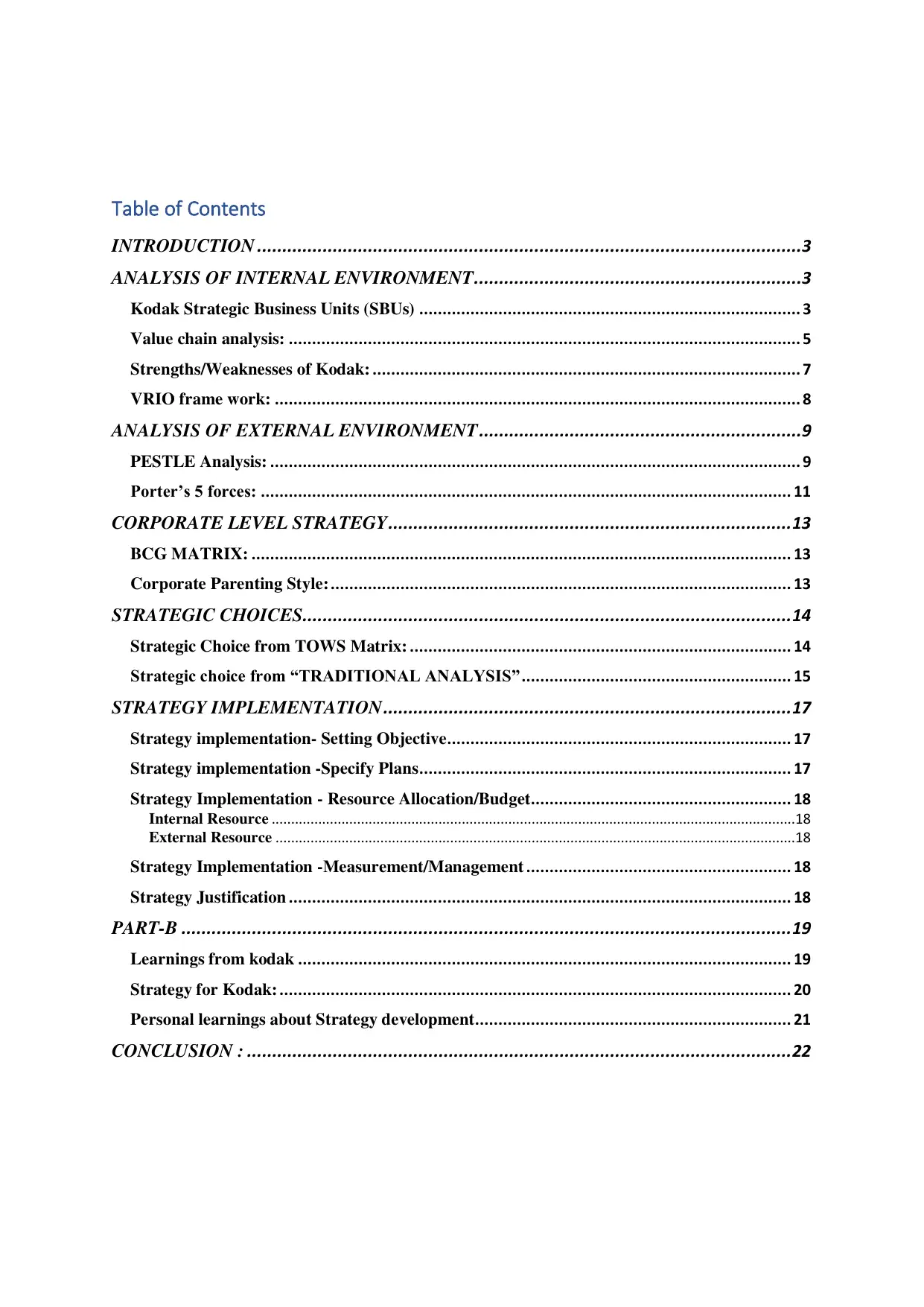
Table of Contents
INTRODUCTION ............................................................................................................3
ANALYSIS OF INTERNAL ENVIRONMENT .................................................................3
Kodak Strategic Business Units (SBUs) .................................................................................. 3
Value chain analysis: .............................................................................................................. 5
Strengths/Weaknesses of Kodak: ............................................................................................ 7
VRIO frame work: ................................................................................................................. 8
ANALYSIS OF EXTERNAL ENVIRONMENT ................................................................9
PESTLE Analysis: .................................................................................................................. 9
Porter’s 5 forces: .................................................................................................................. 11
CORPORATE LEVEL STRATEGY ................................................................................13
BCG MATRIX: .................................................................................................................... 13
Corporate Parenting Style: ................................................................................................... 13
STRATEGIC CHOICES.................................................................................................14
Strategic Choice from TOWS Matrix: .................................................................................. 14
Strategic choice from “TRADITIONAL ANALYSIS” .......................................................... 15
STRATEGY IMPLEMENTATION .................................................................................17
Strategy implementation- Setting Objective.......................................................................... 17
Strategy implementation -Specify Plans................................................................................ 17
Strategy Implementation - Resource Allocation/Budget........................................................ 18
Internal Resource .......................................................................................................................................18
External Resource ......................................................................................................................................18
Strategy Implementation -Measurement/Management ......................................................... 18
Strategy Justification ............................................................................................................ 18
PART-B .........................................................................................................................19
Learnings from kodak .......................................................................................................... 19
Strategy for Kodak: .............................................................................................................. 20
Personal learnings about Strategy development.................................................................... 21
CONCLUSION : ............................................................................................................22
INTRODUCTION ............................................................................................................3
ANALYSIS OF INTERNAL ENVIRONMENT .................................................................3
Kodak Strategic Business Units (SBUs) .................................................................................. 3
Value chain analysis: .............................................................................................................. 5
Strengths/Weaknesses of Kodak: ............................................................................................ 7
VRIO frame work: ................................................................................................................. 8
ANALYSIS OF EXTERNAL ENVIRONMENT ................................................................9
PESTLE Analysis: .................................................................................................................. 9
Porter’s 5 forces: .................................................................................................................. 11
CORPORATE LEVEL STRATEGY ................................................................................13
BCG MATRIX: .................................................................................................................... 13
Corporate Parenting Style: ................................................................................................... 13
STRATEGIC CHOICES.................................................................................................14
Strategic Choice from TOWS Matrix: .................................................................................. 14
Strategic choice from “TRADITIONAL ANALYSIS” .......................................................... 15
STRATEGY IMPLEMENTATION .................................................................................17
Strategy implementation- Setting Objective.......................................................................... 17
Strategy implementation -Specify Plans................................................................................ 17
Strategy Implementation - Resource Allocation/Budget........................................................ 18
Internal Resource .......................................................................................................................................18
External Resource ......................................................................................................................................18
Strategy Implementation -Measurement/Management ......................................................... 18
Strategy Justification ............................................................................................................ 18
PART-B .........................................................................................................................19
Learnings from kodak .......................................................................................................... 19
Strategy for Kodak: .............................................................................................................. 20
Personal learnings about Strategy development.................................................................... 21
CONCLUSION : ............................................................................................................22
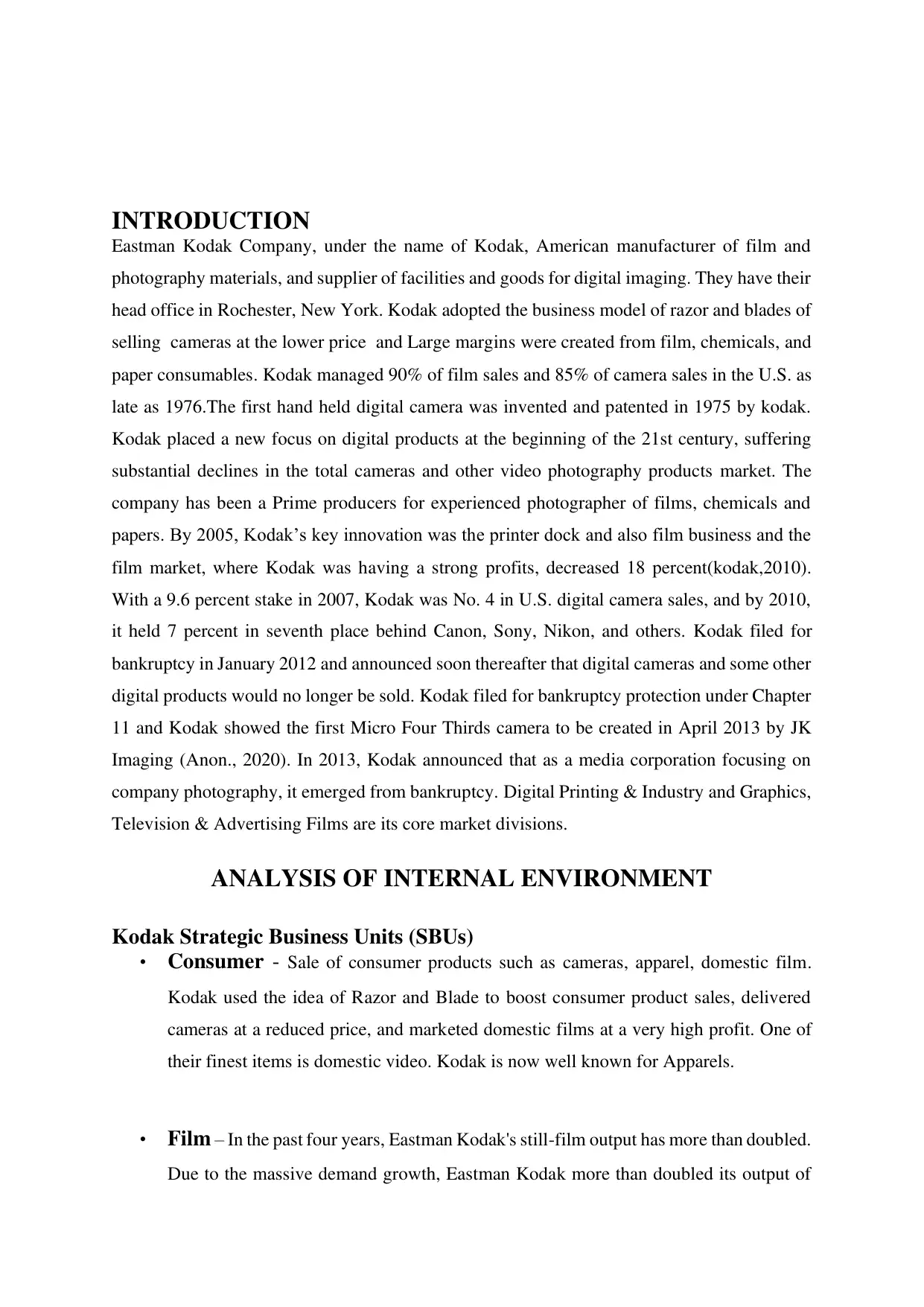
INTRODUCTION
Eastman Kodak Company, under the name of Kodak, American manufacturer of film and
photography materials, and supplier of facilities and goods for digital imaging. They have their
head office in Rochester, New York. Kodak adopted the business model of razor and blades of
selling cameras at the lower price and Large margins were created from film, chemicals, and
paper consumables. Kodak managed 90% of film sales and 85% of camera sales in the U.S. as
late as 1976.The first hand held digital camera was invented and patented in 1975 by kodak.
Kodak placed a new focus on digital products at the beginning of the 21st century, suffering
substantial declines in the total cameras and other video photography products market. The
company has been a Prime producers for experienced photographer of films, chemicals and
papers. By 2005, Kodak’s key innovation was the printer dock and also film business and the
film market, where Kodak was having a strong profits, decreased 18 percent(kodak,2010).
With a 9.6 percent stake in 2007, Kodak was No. 4 in U.S. digital camera sales, and by 2010,
it held 7 percent in seventh place behind Canon, Sony, Nikon, and others. Kodak filed for
bankruptcy in January 2012 and announced soon thereafter that digital cameras and some other
digital products would no longer be sold. Kodak filed for bankruptcy protection under Chapter
11 and Kodak showed the first Micro Four Thirds camera to be created in April 2013 by JK
Imaging (Anon., 2020). In 2013, Kodak announced that as a media corporation focusing on
company photography, it emerged from bankruptcy. Digital Printing & Industry and Graphics,
Television & Advertising Films are its core market divisions.
ANALYSIS OF INTERNAL ENVIRONMENT
Kodak Strategic Business Units (SBUs)
• Consumer - Sale of consumer products such as cameras, apparel, domestic film.
Kodak used the idea of Razor and Blade to boost consumer product sales, delivered
cameras at a reduced price, and marketed domestic films at a very high profit. One of
their finest items is domestic video. Kodak is now well known for Apparels.
• Film – In the past four years, Eastman Kodak's still-film output has more than doubled.
Due to the massive demand growth, Eastman Kodak more than doubled its output of
Eastman Kodak Company, under the name of Kodak, American manufacturer of film and
photography materials, and supplier of facilities and goods for digital imaging. They have their
head office in Rochester, New York. Kodak adopted the business model of razor and blades of
selling cameras at the lower price and Large margins were created from film, chemicals, and
paper consumables. Kodak managed 90% of film sales and 85% of camera sales in the U.S. as
late as 1976.The first hand held digital camera was invented and patented in 1975 by kodak.
Kodak placed a new focus on digital products at the beginning of the 21st century, suffering
substantial declines in the total cameras and other video photography products market. The
company has been a Prime producers for experienced photographer of films, chemicals and
papers. By 2005, Kodak’s key innovation was the printer dock and also film business and the
film market, where Kodak was having a strong profits, decreased 18 percent(kodak,2010).
With a 9.6 percent stake in 2007, Kodak was No. 4 in U.S. digital camera sales, and by 2010,
it held 7 percent in seventh place behind Canon, Sony, Nikon, and others. Kodak filed for
bankruptcy in January 2012 and announced soon thereafter that digital cameras and some other
digital products would no longer be sold. Kodak filed for bankruptcy protection under Chapter
11 and Kodak showed the first Micro Four Thirds camera to be created in April 2013 by JK
Imaging (Anon., 2020). In 2013, Kodak announced that as a media corporation focusing on
company photography, it emerged from bankruptcy. Digital Printing & Industry and Graphics,
Television & Advertising Films are its core market divisions.
ANALYSIS OF INTERNAL ENVIRONMENT
Kodak Strategic Business Units (SBUs)
• Consumer - Sale of consumer products such as cameras, apparel, domestic film.
Kodak used the idea of Razor and Blade to boost consumer product sales, delivered
cameras at a reduced price, and marketed domestic films at a very high profit. One of
their finest items is domestic video. Kodak is now well known for Apparels.
• Film – In the past four years, Eastman Kodak's still-film output has more than doubled.
Due to the massive demand growth, Eastman Kodak more than doubled its output of
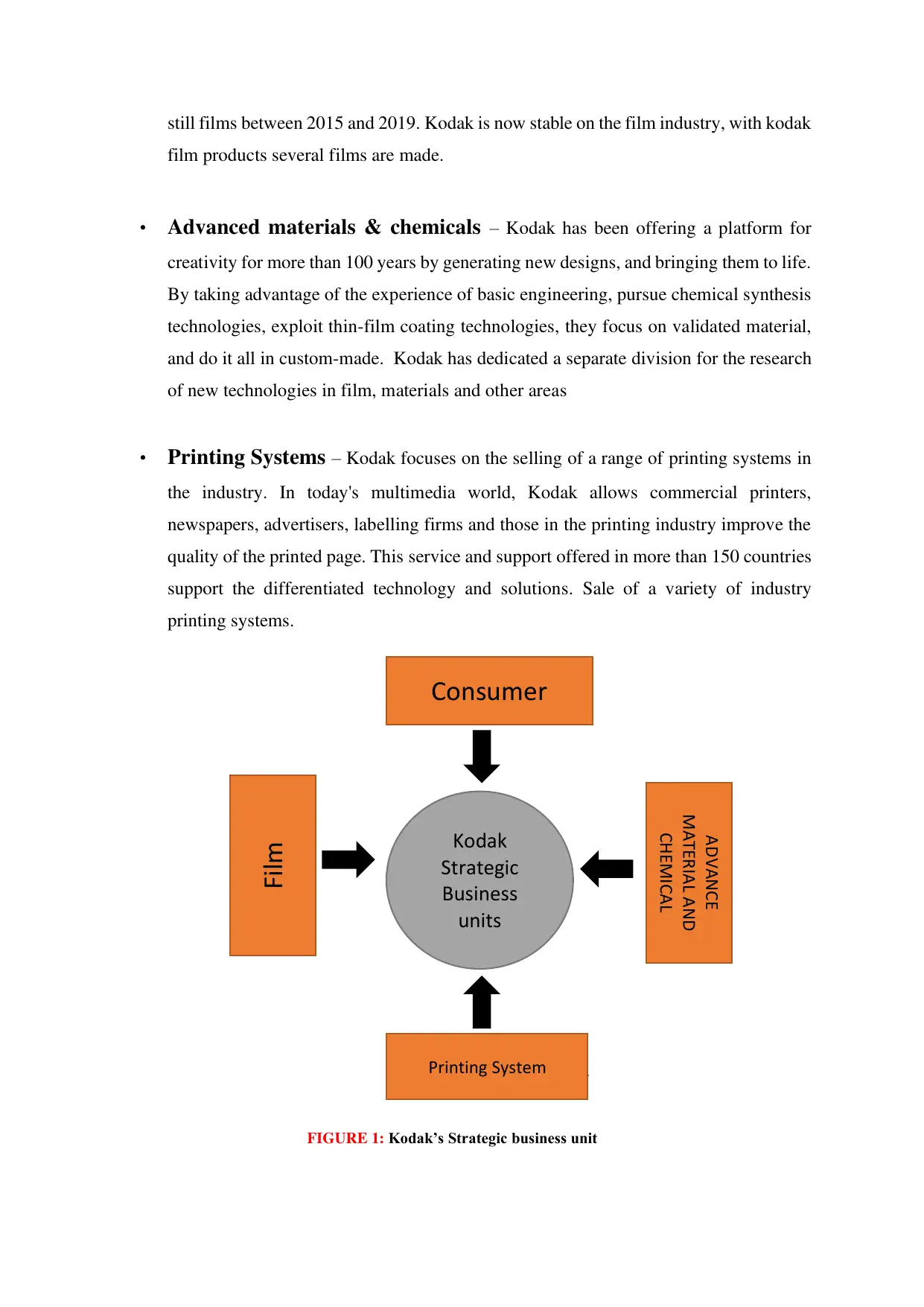
still films between 2015 and 2019. Kodak is now stable on the film industry, with kodak
film products several films are made.
• Advanced materials & chemicals – Kodak has been offering a platform for
creativity for more than 100 years by generating new designs, and bringing them to life.
By taking advantage of the experience of basic engineering, pursue chemical synthesis
technologies, exploit thin-film coating technologies, they focus on validated material,
and do it all in custom-made. Kodak has dedicated a separate division for the research
of new technologies in film, materials and other areas
• Printing Systems – Kodak focuses on the selling of a range of printing systems in
the industry. In today's multimedia world, Kodak allows commercial printers,
newspapers, advertisers, labelling firms and those in the printing industry improve the
quality of the printed page. This service and support offered in more than 150 countries
support the differentiated technology and solutions. Sale of a variety of industry
printing systems.
FIGURE 1: Kodak SBU’S
FIGURE 1: Kodak’s Strategic business unit
Kodak
Strategic
Business
units
Consumer
ADVANCE
MATERIAL AND
CHEMICAL
Film
Printing System
film products several films are made.
• Advanced materials & chemicals – Kodak has been offering a platform for
creativity for more than 100 years by generating new designs, and bringing them to life.
By taking advantage of the experience of basic engineering, pursue chemical synthesis
technologies, exploit thin-film coating technologies, they focus on validated material,
and do it all in custom-made. Kodak has dedicated a separate division for the research
of new technologies in film, materials and other areas
• Printing Systems – Kodak focuses on the selling of a range of printing systems in
the industry. In today's multimedia world, Kodak allows commercial printers,
newspapers, advertisers, labelling firms and those in the printing industry improve the
quality of the printed page. This service and support offered in more than 150 countries
support the differentiated technology and solutions. Sale of a variety of industry
printing systems.
FIGURE 1: Kodak SBU’S
FIGURE 1: Kodak’s Strategic business unit
Kodak
Strategic
Business
units
Consumer
ADVANCE
MATERIAL AND
CHEMICAL
Film
Printing System
Secure Best Marks with AI Grader
Need help grading? Try our AI Grader for instant feedback on your assignments.
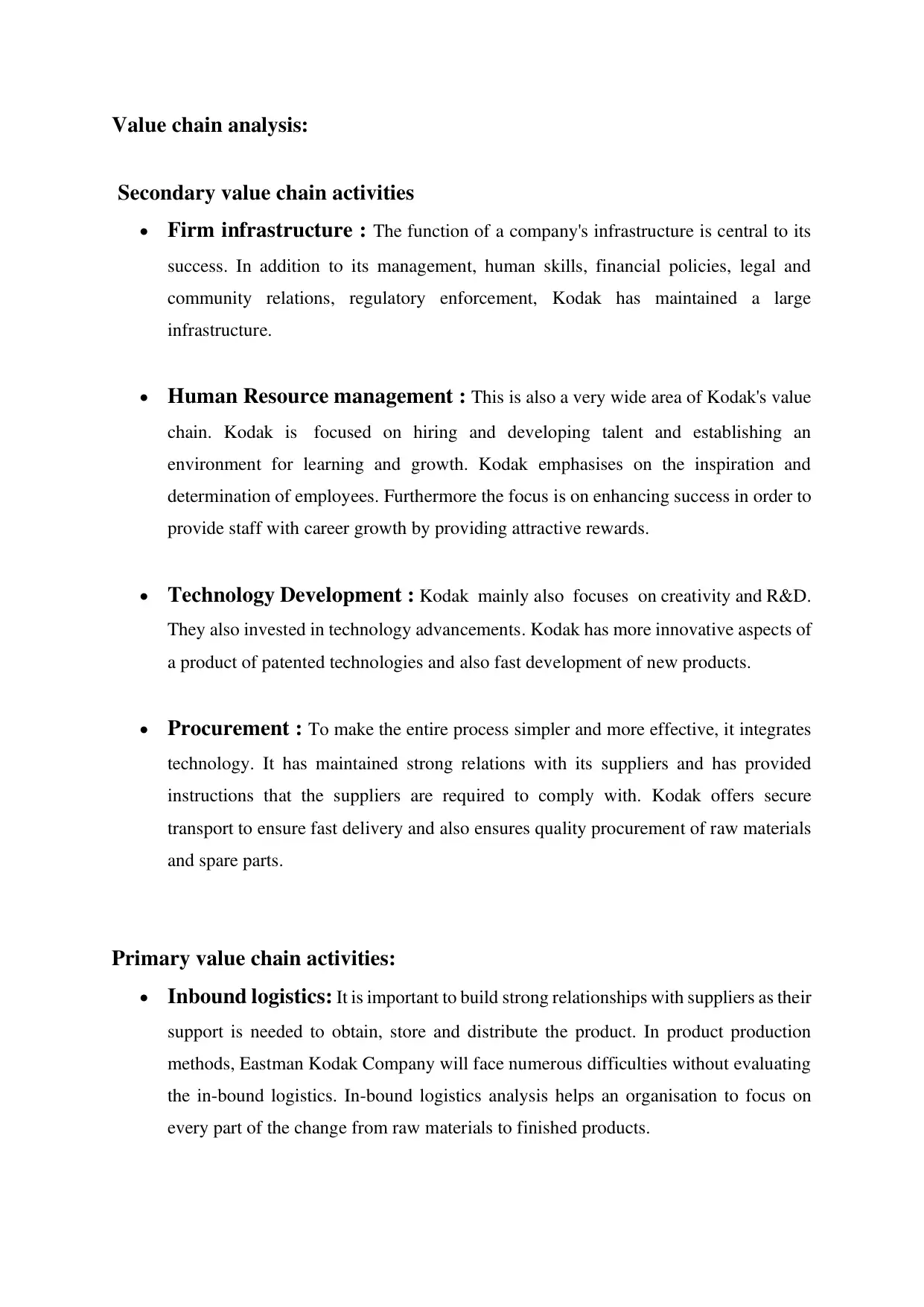
Value chain analysis:
Secondary value chain activities
• Firm infrastructure : The function of a company's infrastructure is central to its
success. In addition to its management, human skills, financial policies, legal and
community relations, regulatory enforcement, Kodak has maintained a large
infrastructure.
• Human Resource management : This is also a very wide area of Kodak's value
chain. Kodak is focused on hiring and developing talent and establishing an
environment for learning and growth. Kodak emphasises on the inspiration and
determination of employees. Furthermore the focus is on enhancing success in order to
provide staff with career growth by providing attractive rewards.
• Technology Development : Kodak mainly also focuses on creativity and R&D.
They also invested in technology advancements. Kodak has more innovative aspects of
a product of patented technologies and also fast development of new products.
• Procurement : To make the entire process simpler and more effective, it integrates
technology. It has maintained strong relations with its suppliers and has provided
instructions that the suppliers are required to comply with. Kodak offers secure
transport to ensure fast delivery and also ensures quality procurement of raw materials
and spare parts.
Primary value chain activities:
• Inbound logistics: It is important to build strong relationships with suppliers as their
support is needed to obtain, store and distribute the product. In product production
methods, Eastman Kodak Company will face numerous difficulties without evaluating
the in-bound logistics. In-bound logistics analysis helps an organisation to focus on
every part of the change from raw materials to finished products.
Secondary value chain activities
• Firm infrastructure : The function of a company's infrastructure is central to its
success. In addition to its management, human skills, financial policies, legal and
community relations, regulatory enforcement, Kodak has maintained a large
infrastructure.
• Human Resource management : This is also a very wide area of Kodak's value
chain. Kodak is focused on hiring and developing talent and establishing an
environment for learning and growth. Kodak emphasises on the inspiration and
determination of employees. Furthermore the focus is on enhancing success in order to
provide staff with career growth by providing attractive rewards.
• Technology Development : Kodak mainly also focuses on creativity and R&D.
They also invested in technology advancements. Kodak has more innovative aspects of
a product of patented technologies and also fast development of new products.
• Procurement : To make the entire process simpler and more effective, it integrates
technology. It has maintained strong relations with its suppliers and has provided
instructions that the suppliers are required to comply with. Kodak offers secure
transport to ensure fast delivery and also ensures quality procurement of raw materials
and spare parts.
Primary value chain activities:
• Inbound logistics: It is important to build strong relationships with suppliers as their
support is needed to obtain, store and distribute the product. In product production
methods, Eastman Kodak Company will face numerous difficulties without evaluating
the in-bound logistics. In-bound logistics analysis helps an organisation to focus on
every part of the change from raw materials to finished products.
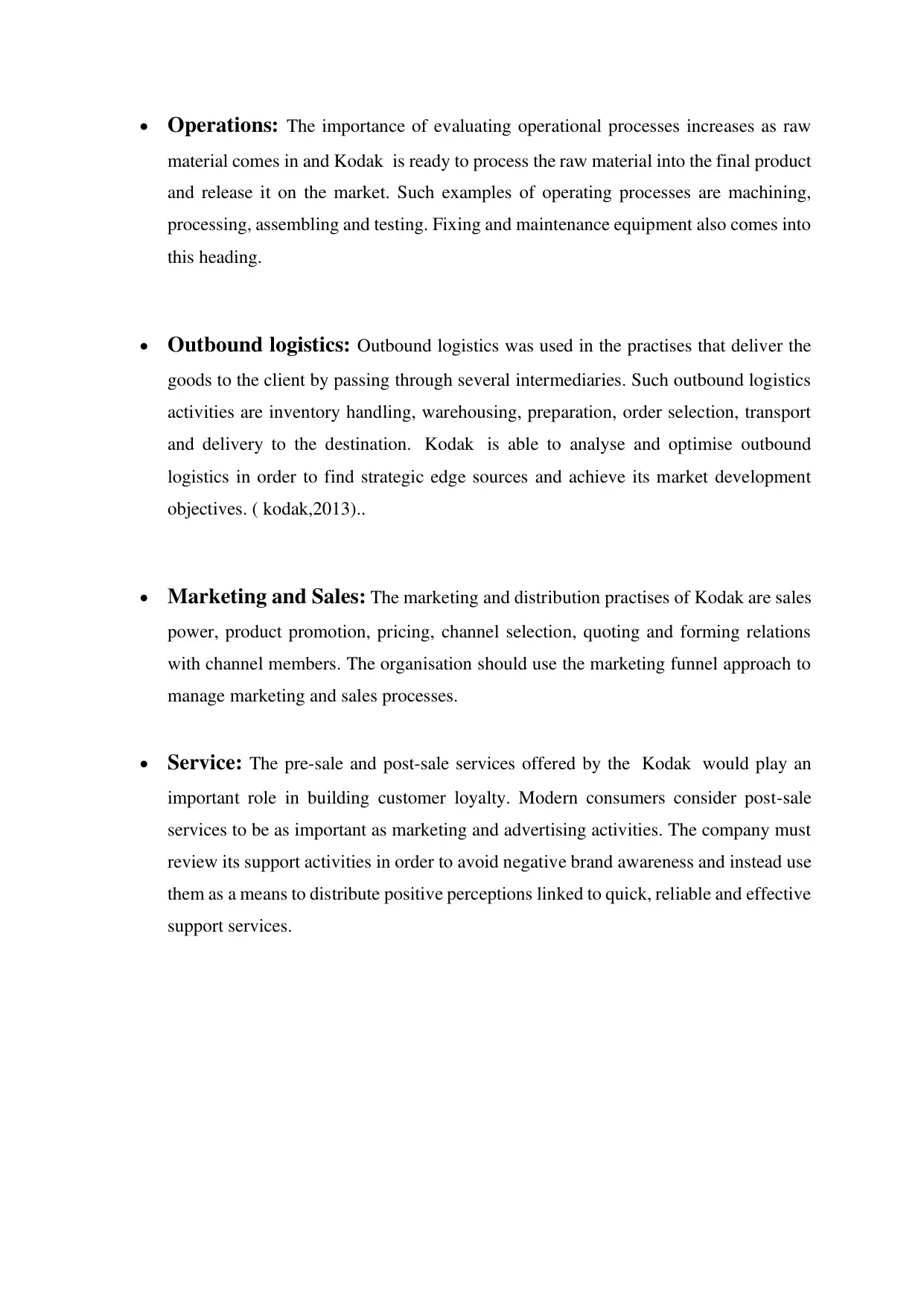
• Operations: The importance of evaluating operational processes increases as raw
material comes in and Kodak is ready to process the raw material into the final product
and release it on the market. Such examples of operating processes are machining,
processing, assembling and testing. Fixing and maintenance equipment also comes into
this heading.
• Outbound logistics: Outbound logistics was used in the practises that deliver the
goods to the client by passing through several intermediaries. Such outbound logistics
activities are inventory handling, warehousing, preparation, order selection, transport
and delivery to the destination. Kodak is able to analyse and optimise outbound
logistics in order to find strategic edge sources and achieve its market development
objectives. ( kodak,2013)..
• Marketing and Sales: The marketing and distribution practises of Kodak are sales
power, product promotion, pricing, channel selection, quoting and forming relations
with channel members. The organisation should use the marketing funnel approach to
manage marketing and sales processes.
• Service: The pre-sale and post-sale services offered by the Kodak would play an
important role in building customer loyalty. Modern consumers consider post-sale
services to be as important as marketing and advertising activities. The company must
review its support activities in order to avoid negative brand awareness and instead use
them as a means to distribute positive perceptions linked to quick, reliable and effective
support services.
material comes in and Kodak is ready to process the raw material into the final product
and release it on the market. Such examples of operating processes are machining,
processing, assembling and testing. Fixing and maintenance equipment also comes into
this heading.
• Outbound logistics: Outbound logistics was used in the practises that deliver the
goods to the client by passing through several intermediaries. Such outbound logistics
activities are inventory handling, warehousing, preparation, order selection, transport
and delivery to the destination. Kodak is able to analyse and optimise outbound
logistics in order to find strategic edge sources and achieve its market development
objectives. ( kodak,2013)..
• Marketing and Sales: The marketing and distribution practises of Kodak are sales
power, product promotion, pricing, channel selection, quoting and forming relations
with channel members. The organisation should use the marketing funnel approach to
manage marketing and sales processes.
• Service: The pre-sale and post-sale services offered by the Kodak would play an
important role in building customer loyalty. Modern consumers consider post-sale
services to be as important as marketing and advertising activities. The company must
review its support activities in order to avoid negative brand awareness and instead use
them as a means to distribute positive perceptions linked to quick, reliable and effective
support services.
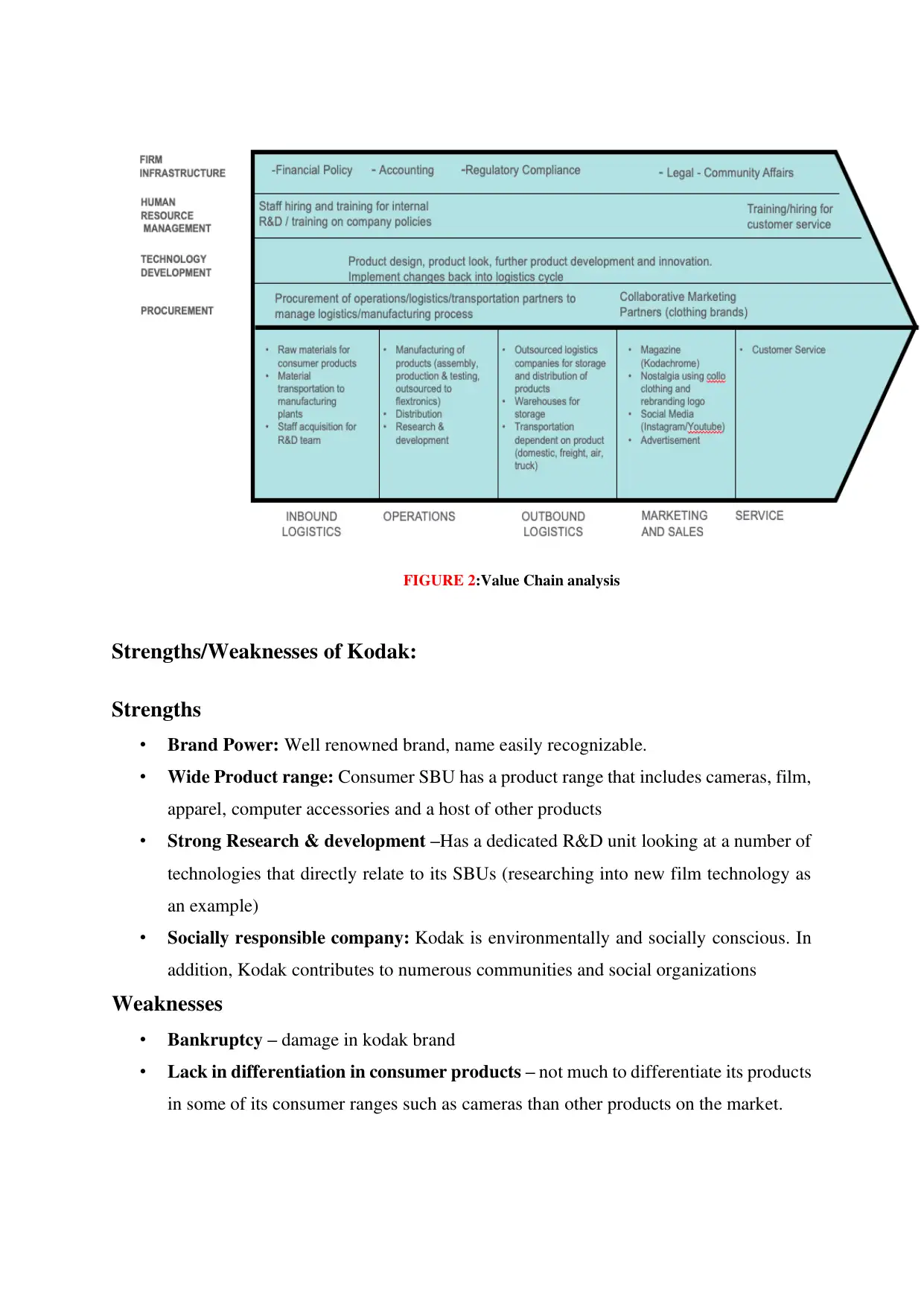
FIGURE 2:Value Chain analysis
Strengths/Weaknesses of Kodak:
Strengths
• Brand Power: Well renowned brand, name easily recognizable.
• Wide Product range: Consumer SBU has a product range that includes cameras, film,
apparel, computer accessories and a host of other products
• Strong Research & development –Has a dedicated R&D unit looking at a number of
technologies that directly relate to its SBUs (researching into new film technology as
an example)
• Socially responsible company: Kodak is environmentally and socially conscious. In
addition, Kodak contributes to numerous communities and social organizations
Weaknesses
• Bankruptcy – damage in kodak brand
• Lack in differentiation in consumer products – not much to differentiate its products
in some of its consumer ranges such as cameras than other products on the market.
Strengths/Weaknesses of Kodak:
Strengths
• Brand Power: Well renowned brand, name easily recognizable.
• Wide Product range: Consumer SBU has a product range that includes cameras, film,
apparel, computer accessories and a host of other products
• Strong Research & development –Has a dedicated R&D unit looking at a number of
technologies that directly relate to its SBUs (researching into new film technology as
an example)
• Socially responsible company: Kodak is environmentally and socially conscious. In
addition, Kodak contributes to numerous communities and social organizations
Weaknesses
• Bankruptcy – damage in kodak brand
• Lack in differentiation in consumer products – not much to differentiate its products
in some of its consumer ranges such as cameras than other products on the market.
Paraphrase This Document
Need a fresh take? Get an instant paraphrase of this document with our AI Paraphraser
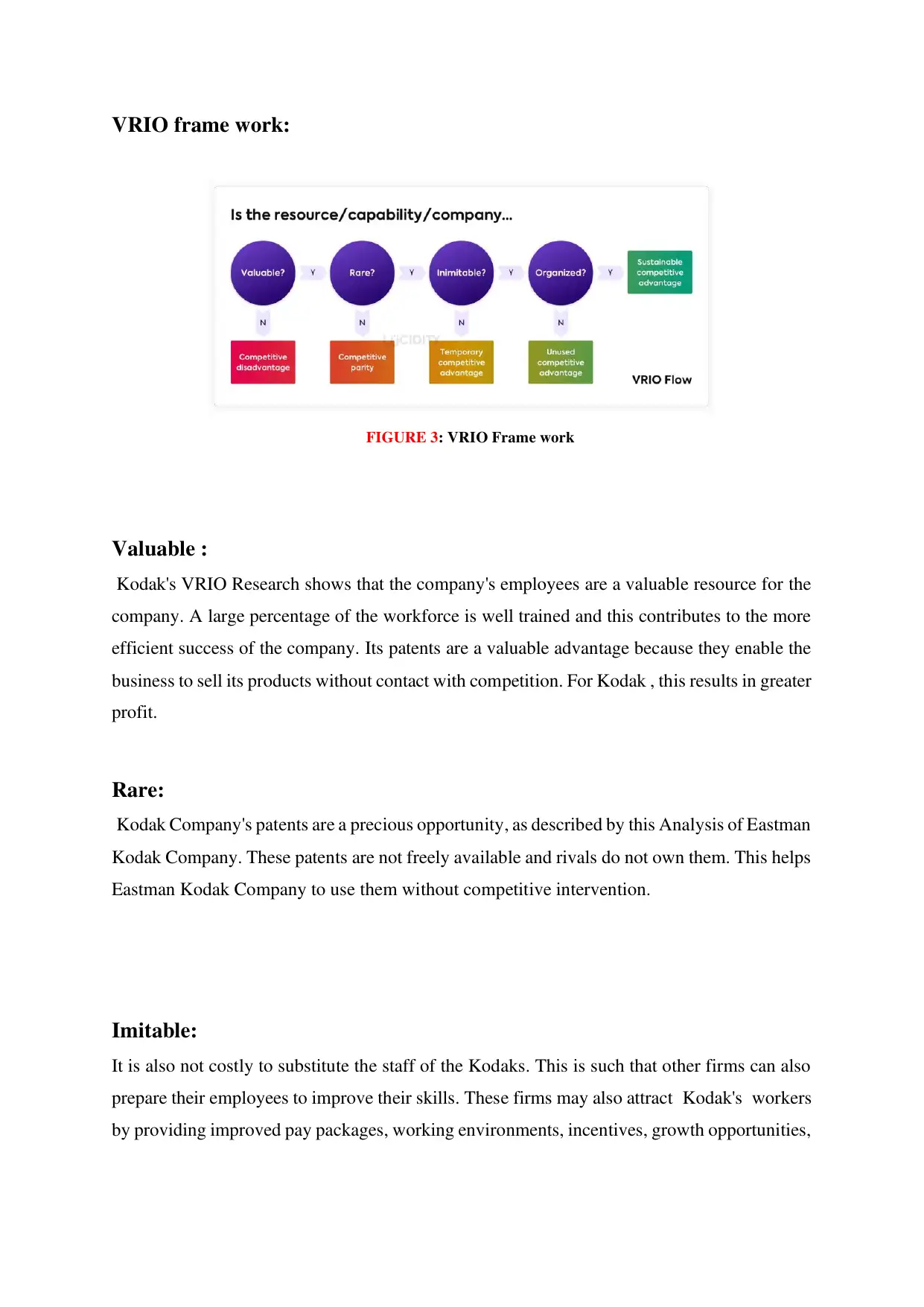
VRIO frame work:
FIGURE 3: VRIO Frame work
Valuable :
Kodak's VRIO Research shows that the company's employees are a valuable resource for the
company. A large percentage of the workforce is well trained and this contributes to the more
efficient success of the company. Its patents are a valuable advantage because they enable the
business to sell its products without contact with competition. For Kodak , this results in greater
profit.
Rare:
Kodak Company's patents are a precious opportunity, as described by this Analysis of Eastman
Kodak Company. These patents are not freely available and rivals do not own them. This helps
Eastman Kodak Company to use them without competitive intervention.
Imitable:
It is also not costly to substitute the staff of the Kodaks. This is such that other firms can also
prepare their employees to improve their skills. These firms may also attract Kodak's workers
by providing improved pay packages, working environments, incentives, growth opportunities,
FIGURE 3: VRIO Frame work
Valuable :
Kodak's VRIO Research shows that the company's employees are a valuable resource for the
company. A large percentage of the workforce is well trained and this contributes to the more
efficient success of the company. Its patents are a valuable advantage because they enable the
business to sell its products without contact with competition. For Kodak , this results in greater
profit.
Rare:
Kodak Company's patents are a precious opportunity, as described by this Analysis of Eastman
Kodak Company. These patents are not freely available and rivals do not own them. This helps
Eastman Kodak Company to use them without competitive intervention.
Imitable:
It is also not costly to substitute the staff of the Kodaks. This is such that other firms can also
prepare their employees to improve their skills. These firms may also attract Kodak's workers
by providing improved pay packages, working environments, incentives, growth opportunities,

etc. This gives Kodak's workers a tool that offers a temporary competitive edge. In future,
competition can acquire these.
Organised:
Kodak has not organised their patents to well. To their full extent, these patents are not regularly
used by the company. There is an unused competitive edge that can be transformed into a
reliable competitive advantage if the Kodak manages to sell proprietary products until the
patents expire.( kodak,2015). The Kodak market network is coordinated and aims to reach out
to its consumers by ensuring that products are available in all its outlets. Thus these instruments
are a source of sustained competitive advantage for Kodak
ANALYSIS OF EXTERNAL ENVIRONMENT
PESTLE Analysis:
FIGURE 4:PESTLE Analysis
Political:
• Hazardous waste regulation 2005(UK law)
• UK foreign trade bill 2017
• US foreign trade policy 2020
competition can acquire these.
Organised:
Kodak has not organised their patents to well. To their full extent, these patents are not regularly
used by the company. There is an unused competitive edge that can be transformed into a
reliable competitive advantage if the Kodak manages to sell proprietary products until the
patents expire.( kodak,2015). The Kodak market network is coordinated and aims to reach out
to its consumers by ensuring that products are available in all its outlets. Thus these instruments
are a source of sustained competitive advantage for Kodak
ANALYSIS OF EXTERNAL ENVIRONMENT
PESTLE Analysis:
FIGURE 4:PESTLE Analysis
Political:
• Hazardous waste regulation 2005(UK law)
• UK foreign trade bill 2017
• US foreign trade policy 2020
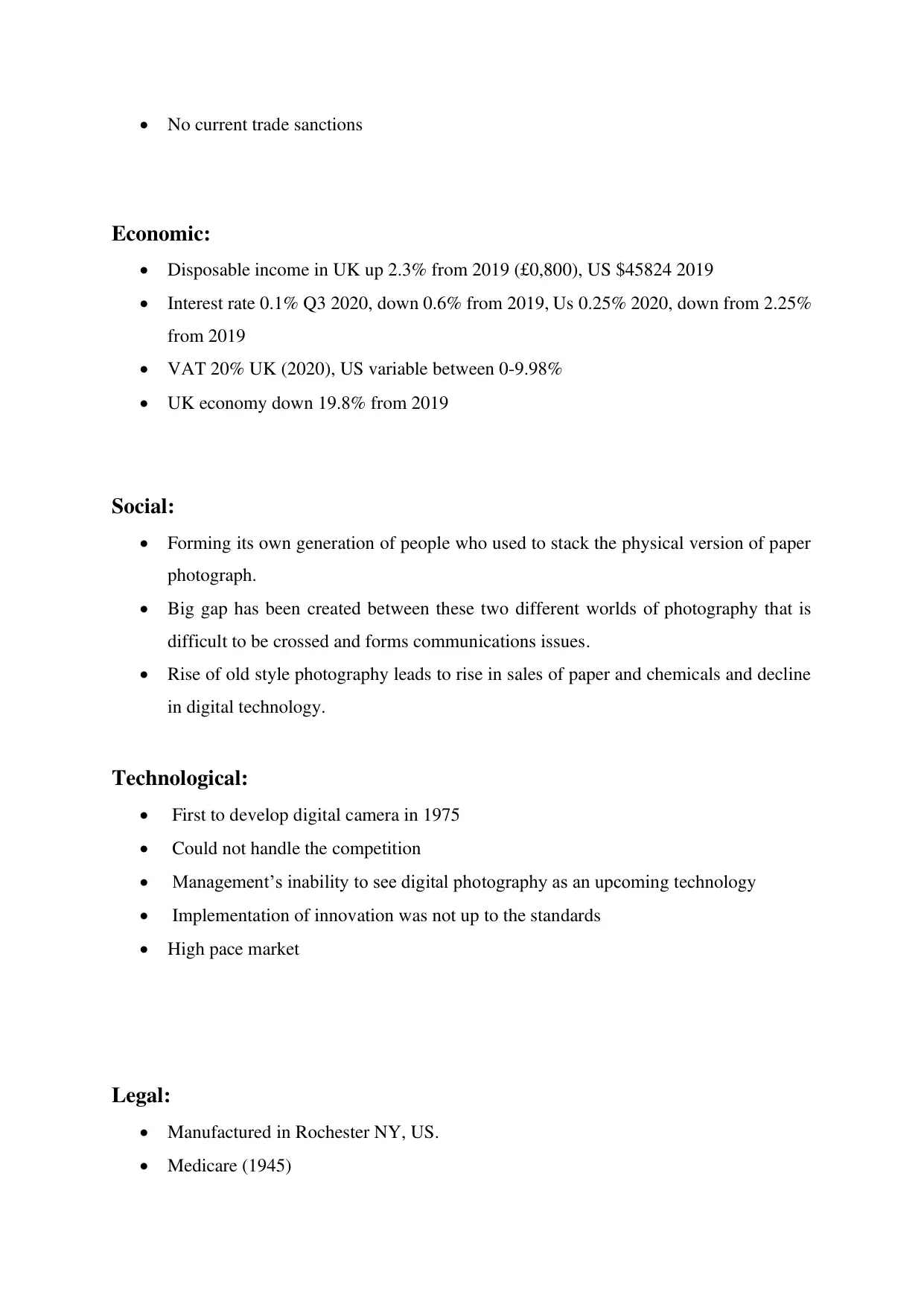
• No current trade sanctions
Economic:
• Disposable income in UK up 2.3% from 2019 (£0,800), US $45824 2019
• Interest rate 0.1% Q3 2020, down 0.6% from 2019, Us 0.25% 2020, down from 2.25%
from 2019
• VAT 20% UK (2020), US variable between 0-9.98%
• UK economy down 19.8% from 2019
Social:
• Forming its own generation of people who used to stack the physical version of paper
photograph.
• Big gap has been created between these two different worlds of photography that is
difficult to be crossed and forms communications issues.
• Rise of old style photography leads to rise in sales of paper and chemicals and decline
in digital technology.
Technological:
• First to develop digital camera in 1975
• Could not handle the competition
• Management’s inability to see digital photography as an upcoming technology
• Implementation of innovation was not up to the standards
• High pace market
Legal:
• Manufactured in Rochester NY, US.
• Medicare (1945)
Economic:
• Disposable income in UK up 2.3% from 2019 (£0,800), US $45824 2019
• Interest rate 0.1% Q3 2020, down 0.6% from 2019, Us 0.25% 2020, down from 2.25%
from 2019
• VAT 20% UK (2020), US variable between 0-9.98%
• UK economy down 19.8% from 2019
Social:
• Forming its own generation of people who used to stack the physical version of paper
photograph.
• Big gap has been created between these two different worlds of photography that is
difficult to be crossed and forms communications issues.
• Rise of old style photography leads to rise in sales of paper and chemicals and decline
in digital technology.
Technological:
• First to develop digital camera in 1975
• Could not handle the competition
• Management’s inability to see digital photography as an upcoming technology
• Implementation of innovation was not up to the standards
• High pace market
Legal:
• Manufactured in Rochester NY, US.
• Medicare (1945)
Secure Best Marks with AI Grader
Need help grading? Try our AI Grader for instant feedback on your assignments.
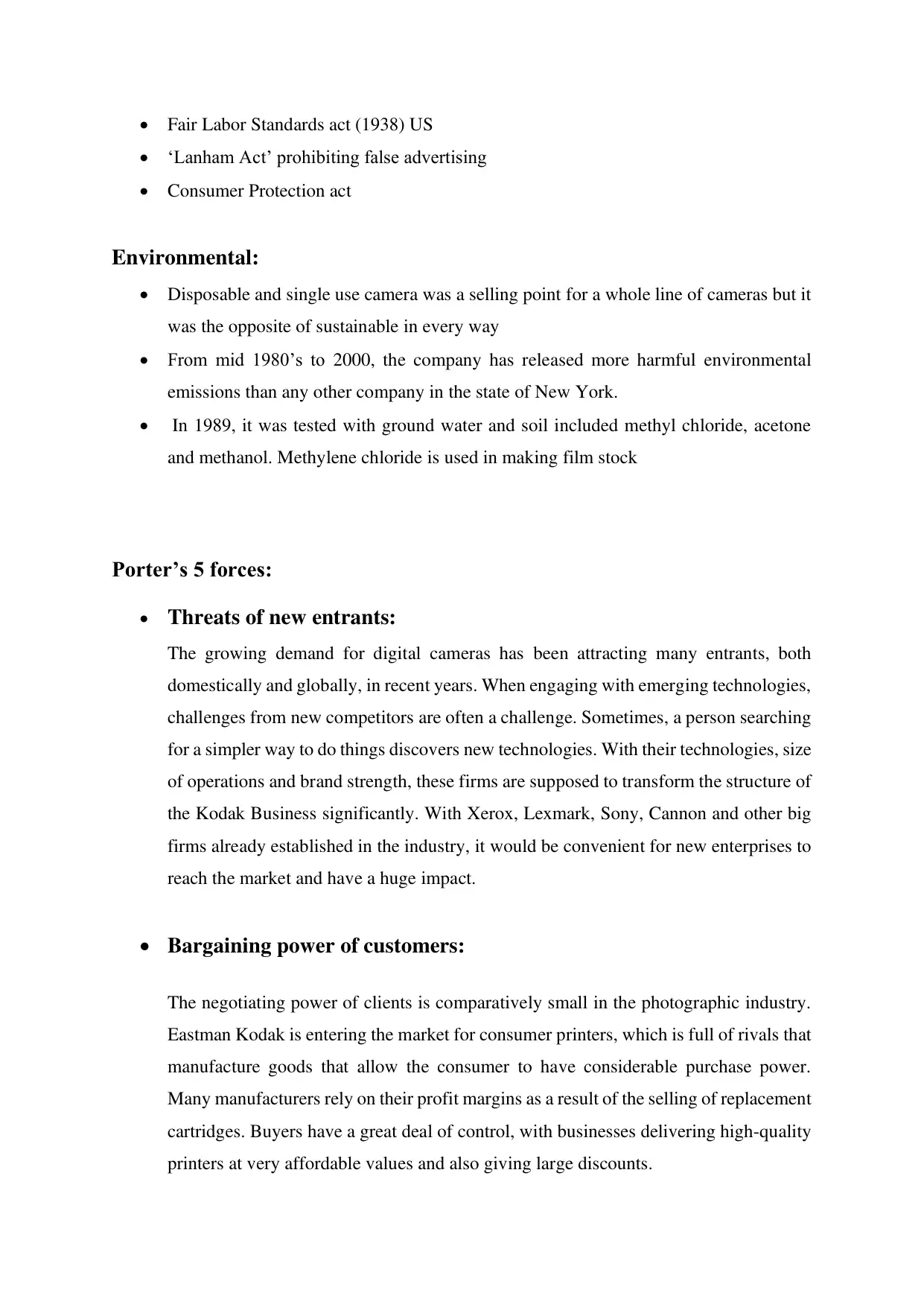
• Fair Labor Standards act (1938) US
• ‘Lanham Act’ prohibiting false advertising
• Consumer Protection act
Environmental:
• Disposable and single use camera was a selling point for a whole line of cameras but it
was the opposite of sustainable in every way
• From mid 1980’s to 2000, the company has released more harmful environmental
emissions than any other company in the state of New York.
• In 1989, it was tested with ground water and soil included methyl chloride, acetone
and methanol. Methylene chloride is used in making film stock
Porter’s 5 forces:
• Threats of new entrants:
The growing demand for digital cameras has been attracting many entrants, both
domestically and globally, in recent years. When engaging with emerging technologies,
challenges from new competitors are often a challenge. Sometimes, a person searching
for a simpler way to do things discovers new technologies. With their technologies, size
of operations and brand strength, these firms are supposed to transform the structure of
the Kodak Business significantly. With Xerox, Lexmark, Sony, Cannon and other big
firms already established in the industry, it would be convenient for new enterprises to
reach the market and have a huge impact.
• Bargaining power of customers:
The negotiating power of clients is comparatively small in the photographic industry.
Eastman Kodak is entering the market for consumer printers, which is full of rivals that
manufacture goods that allow the consumer to have considerable purchase power.
Many manufacturers rely on their profit margins as a result of the selling of replacement
cartridges. Buyers have a great deal of control, with businesses delivering high-quality
printers at very affordable values and also giving large discounts.
• ‘Lanham Act’ prohibiting false advertising
• Consumer Protection act
Environmental:
• Disposable and single use camera was a selling point for a whole line of cameras but it
was the opposite of sustainable in every way
• From mid 1980’s to 2000, the company has released more harmful environmental
emissions than any other company in the state of New York.
• In 1989, it was tested with ground water and soil included methyl chloride, acetone
and methanol. Methylene chloride is used in making film stock
Porter’s 5 forces:
• Threats of new entrants:
The growing demand for digital cameras has been attracting many entrants, both
domestically and globally, in recent years. When engaging with emerging technologies,
challenges from new competitors are often a challenge. Sometimes, a person searching
for a simpler way to do things discovers new technologies. With their technologies, size
of operations and brand strength, these firms are supposed to transform the structure of
the Kodak Business significantly. With Xerox, Lexmark, Sony, Cannon and other big
firms already established in the industry, it would be convenient for new enterprises to
reach the market and have a huge impact.
• Bargaining power of customers:
The negotiating power of clients is comparatively small in the photographic industry.
Eastman Kodak is entering the market for consumer printers, which is full of rivals that
manufacture goods that allow the consumer to have considerable purchase power.
Many manufacturers rely on their profit margins as a result of the selling of replacement
cartridges. Buyers have a great deal of control, with businesses delivering high-quality
printers at very affordable values and also giving large discounts.
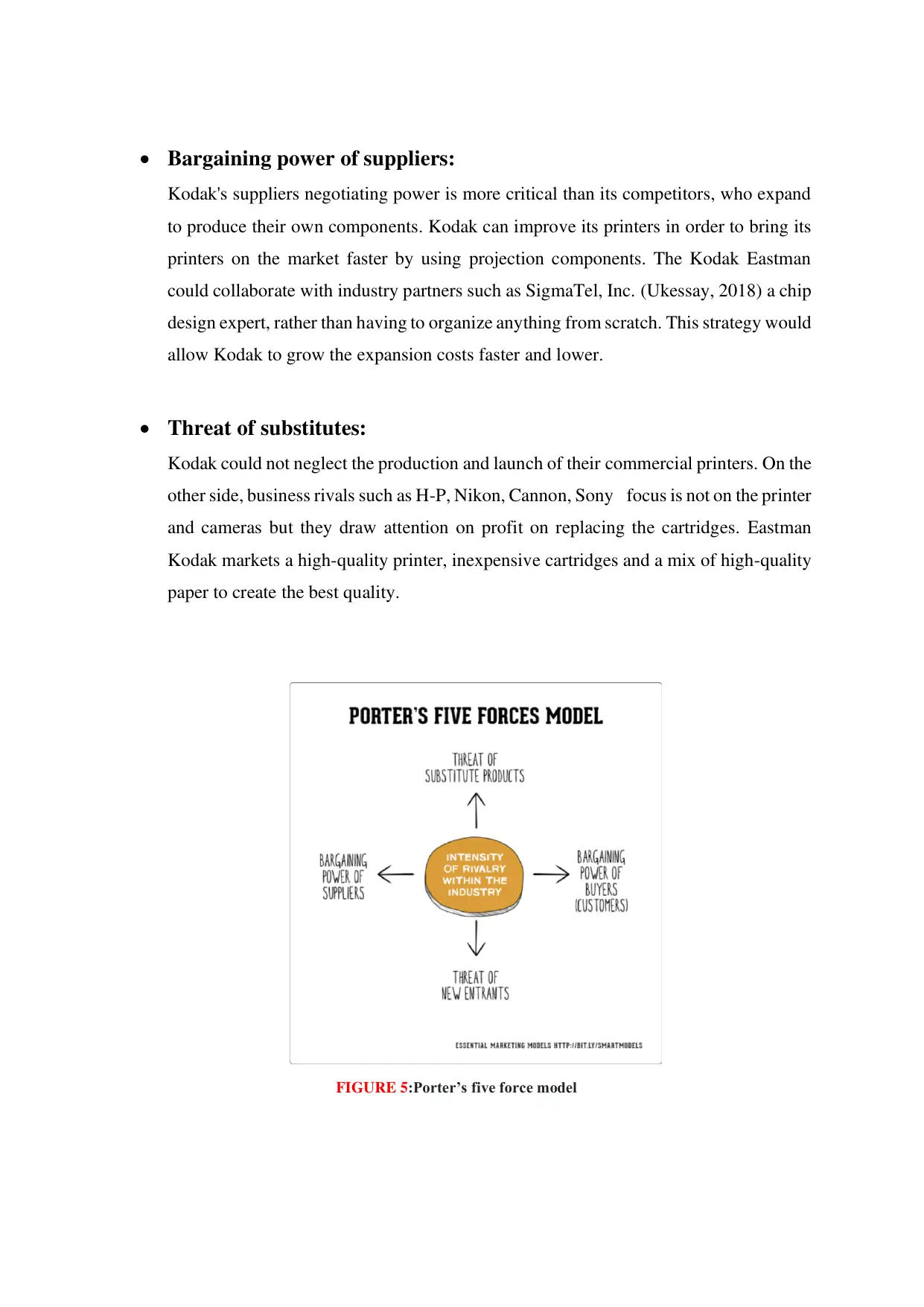
• Bargaining power of suppliers:
Kodak's suppliers negotiating power is more critical than its competitors, who expand
to produce their own components. Kodak can improve its printers in order to bring its
printers on the market faster by using projection components. The Kodak Eastman
could collaborate with industry partners such as SigmaTel, Inc. (Ukessay, 2018) a chip
design expert, rather than having to organize anything from scratch. This strategy would
allow Kodak to grow the expansion costs faster and lower.
• Threat of substitutes:
Kodak could not neglect the production and launch of their commercial printers. On the
other side, business rivals such as H-P, Nikon, Cannon, Sony focus is not on the printer
and cameras but they draw attention on profit on replacing the cartridges. Eastman
Kodak markets a high-quality printer, inexpensive cartridges and a mix of high-quality
paper to create the best quality.
FIGURE 5:Porter’s five force model
Kodak's suppliers negotiating power is more critical than its competitors, who expand
to produce their own components. Kodak can improve its printers in order to bring its
printers on the market faster by using projection components. The Kodak Eastman
could collaborate with industry partners such as SigmaTel, Inc. (Ukessay, 2018) a chip
design expert, rather than having to organize anything from scratch. This strategy would
allow Kodak to grow the expansion costs faster and lower.
• Threat of substitutes:
Kodak could not neglect the production and launch of their commercial printers. On the
other side, business rivals such as H-P, Nikon, Cannon, Sony focus is not on the printer
and cameras but they draw attention on profit on replacing the cartridges. Eastman
Kodak markets a high-quality printer, inexpensive cartridges and a mix of high-quality
paper to create the best quality.
FIGURE 5:Porter’s five force model
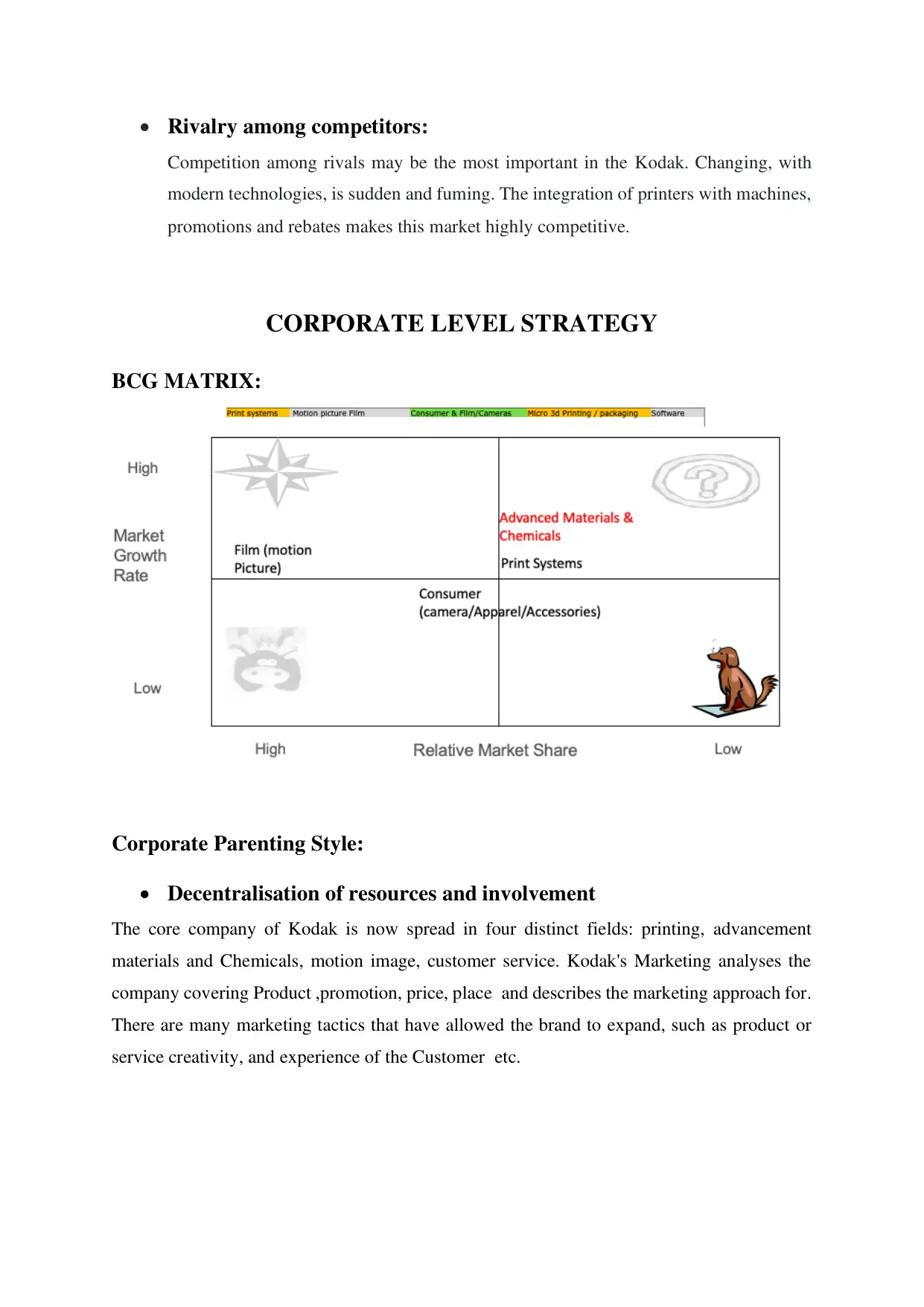
• Rivalry among competitors:
Competition among rivals may be the most important in the Kodak. Changing, with
modern technologies, is sudden and fuming. The integration of printers with machines,
promotions and rebates makes this market highly competitive.
CORPORATE LEVEL STRATEGY
BCG MATRIX:
Corporate Parenting Style:
• Decentralisation of resources and involvement
The core company of Kodak is now spread in four distinct fields: printing, advancement
materials and Chemicals, motion image, customer service. Kodak's Marketing analyses the
company covering Product ,promotion, price, place and describes the marketing approach for.
There are many marketing tactics that have allowed the brand to expand, such as product or
service creativity, and experience of the Customer etc.
Competition among rivals may be the most important in the Kodak. Changing, with
modern technologies, is sudden and fuming. The integration of printers with machines,
promotions and rebates makes this market highly competitive.
CORPORATE LEVEL STRATEGY
BCG MATRIX:
Corporate Parenting Style:
• Decentralisation of resources and involvement
The core company of Kodak is now spread in four distinct fields: printing, advancement
materials and Chemicals, motion image, customer service. Kodak's Marketing analyses the
company covering Product ,promotion, price, place and describes the marketing approach for.
There are many marketing tactics that have allowed the brand to expand, such as product or
service creativity, and experience of the Customer etc.
Paraphrase This Document
Need a fresh take? Get an instant paraphrase of this document with our AI Paraphraser
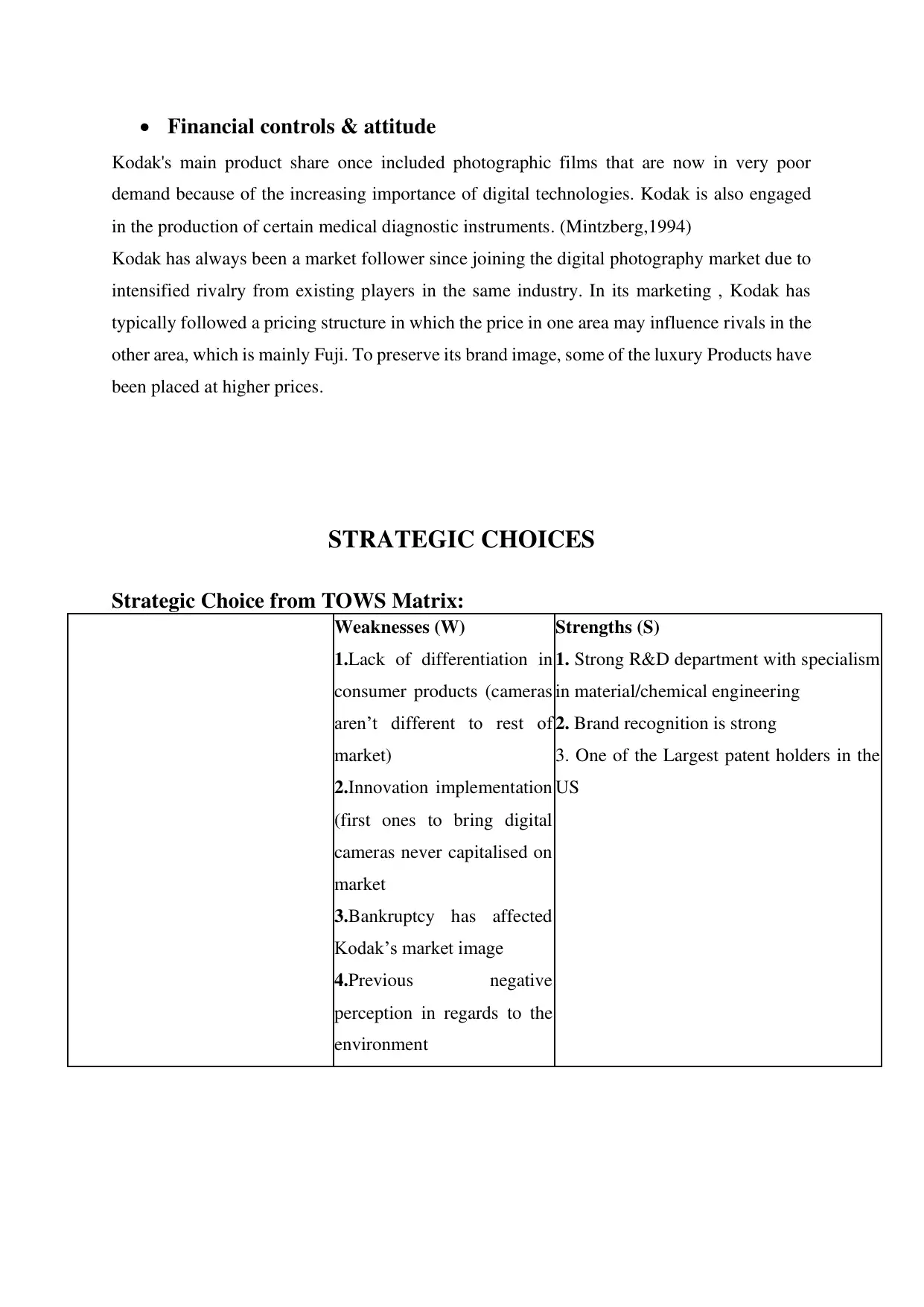
• Financial controls & attitude
Kodak's main product share once included photographic films that are now in very poor
demand because of the increasing importance of digital technologies. Kodak is also engaged
in the production of certain medical diagnostic instruments. (Mintzberg,1994)
Kodak has always been a market follower since joining the digital photography market due to
intensified rivalry from existing players in the same industry. In its marketing , Kodak has
typically followed a pricing structure in which the price in one area may influence rivals in the
other area, which is mainly Fuji. To preserve its brand image, some of the luxury Products have
been placed at higher prices.
STRATEGIC CHOICES
Strategic Choice from TOWS Matrix:
Weaknesses (W)
1.Lack of differentiation in
consumer products (cameras
aren’t different to rest of
market)
2.Innovation implementation
(first ones to bring digital
cameras never capitalised on
market
3.Bankruptcy has affected
Kodak’s market image
4.Previous negative
perception in regards to the
environment
Strengths (S)
1. Strong R&D department with specialism
in material/chemical engineering
2. Brand recognition is strong
3. One of the Largest patent holders in the
US
Kodak's main product share once included photographic films that are now in very poor
demand because of the increasing importance of digital technologies. Kodak is also engaged
in the production of certain medical diagnostic instruments. (Mintzberg,1994)
Kodak has always been a market follower since joining the digital photography market due to
intensified rivalry from existing players in the same industry. In its marketing , Kodak has
typically followed a pricing structure in which the price in one area may influence rivals in the
other area, which is mainly Fuji. To preserve its brand image, some of the luxury Products have
been placed at higher prices.
STRATEGIC CHOICES
Strategic Choice from TOWS Matrix:
Weaknesses (W)
1.Lack of differentiation in
consumer products (cameras
aren’t different to rest of
market)
2.Innovation implementation
(first ones to bring digital
cameras never capitalised on
market
3.Bankruptcy has affected
Kodak’s market image
4.Previous negative
perception in regards to the
environment
Strengths (S)
1. Strong R&D department with specialism
in material/chemical engineering
2. Brand recognition is strong
3. One of the Largest patent holders in the
US

Opportunities (O)
1 Backed by US government to
potentially go into
pharmaceuticals, in medicine
2. Not prevalent in the software
market (printing apps) can
potentially capitalise on this and
grow
3. Sports teams implementation of
AI vision systems for training and
analysis
WO Strategic Options
Implement a new range of
products in consumer goods
SO Strategic Options
1.Pursue innovative solutions to new
markets such as software and sports
combining SBUs (R&D + Camera division)
S1, 02 03
2.Pursue new pharmaceutical market
backed by chemical/material research of
R&D department
Threats (T)
1.Kodak highly capitalising in
nostalgia market, many
competitors are beginning to join
(Fujifilm, Sony). They were stung
on this in the past
2.Covid 19 effecting multiple
industries (films, cinemas closing
down reduced production in films)
3. Change in consumer demands in
the camera market
TW Strategic Options
1.Investment in app/post
production software in films
2.unique marketing
campaign for nostalgia
(Instagram influencers)
ST Strategic Options
1.R&D department to pursue further
innovation in camera technology
2.Sell patents within markets that there is no
long-term development in
Strategic choice from “TRADITIONAL ANALYSIS”
• Feasibility ranked in two categories:
• Can we obtain necessary resource/competency (F1)
• do processes exist to deploy resources/competences (F2)
• Suitability ranked in three categories:
• Positioning right in the industry (S1)
• Does it exploit resources and competences (S2)
1 Backed by US government to
potentially go into
pharmaceuticals, in medicine
2. Not prevalent in the software
market (printing apps) can
potentially capitalise on this and
grow
3. Sports teams implementation of
AI vision systems for training and
analysis
WO Strategic Options
Implement a new range of
products in consumer goods
SO Strategic Options
1.Pursue innovative solutions to new
markets such as software and sports
combining SBUs (R&D + Camera division)
S1, 02 03
2.Pursue new pharmaceutical market
backed by chemical/material research of
R&D department
Threats (T)
1.Kodak highly capitalising in
nostalgia market, many
competitors are beginning to join
(Fujifilm, Sony). They were stung
on this in the past
2.Covid 19 effecting multiple
industries (films, cinemas closing
down reduced production in films)
3. Change in consumer demands in
the camera market
TW Strategic Options
1.Investment in app/post
production software in films
2.unique marketing
campaign for nostalgia
(Instagram influencers)
ST Strategic Options
1.R&D department to pursue further
innovation in camera technology
2.Sell patents within markets that there is no
long-term development in
Strategic choice from “TRADITIONAL ANALYSIS”
• Feasibility ranked in two categories:
• Can we obtain necessary resource/competency (F1)
• do processes exist to deploy resources/competences (F2)
• Suitability ranked in three categories:
• Positioning right in the industry (S1)
• Does it exploit resources and competences (S2)
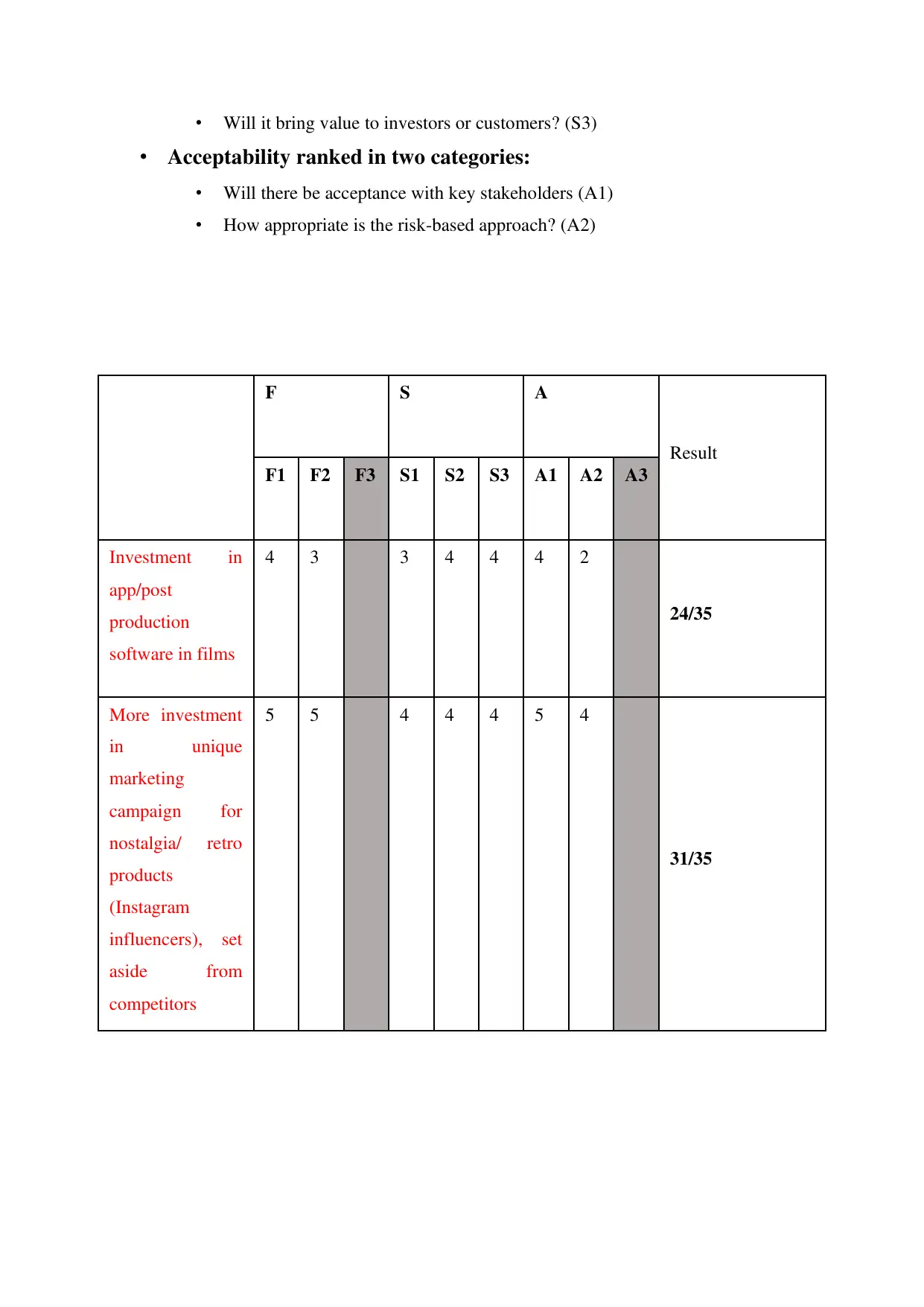
• Will it bring value to investors or customers? (S3)
• Acceptability ranked in two categories:
• Will there be acceptance with key stakeholders (A1)
• How appropriate is the risk-based approach? (A2)
F S A
Result
F1 F2 F3 S1 S2 S3 A1 A2 A3
Investment in
app/post
production
software in films
4 3 3 4 4 4 2
24/35
More investment
in unique
marketing
campaign for
nostalgia/ retro
products
(Instagram
influencers), set
aside from
competitors
5 5 4 4 4 5 4
31/35
• Acceptability ranked in two categories:
• Will there be acceptance with key stakeholders (A1)
• How appropriate is the risk-based approach? (A2)
F S A
Result
F1 F2 F3 S1 S2 S3 A1 A2 A3
Investment in
app/post
production
software in films
4 3 3 4 4 4 2
24/35
More investment
in unique
marketing
campaign for
nostalgia/ retro
products
influencers), set
aside from
competitors
5 5 4 4 4 5 4
31/35
Secure Best Marks with AI Grader
Need help grading? Try our AI Grader for instant feedback on your assignments.
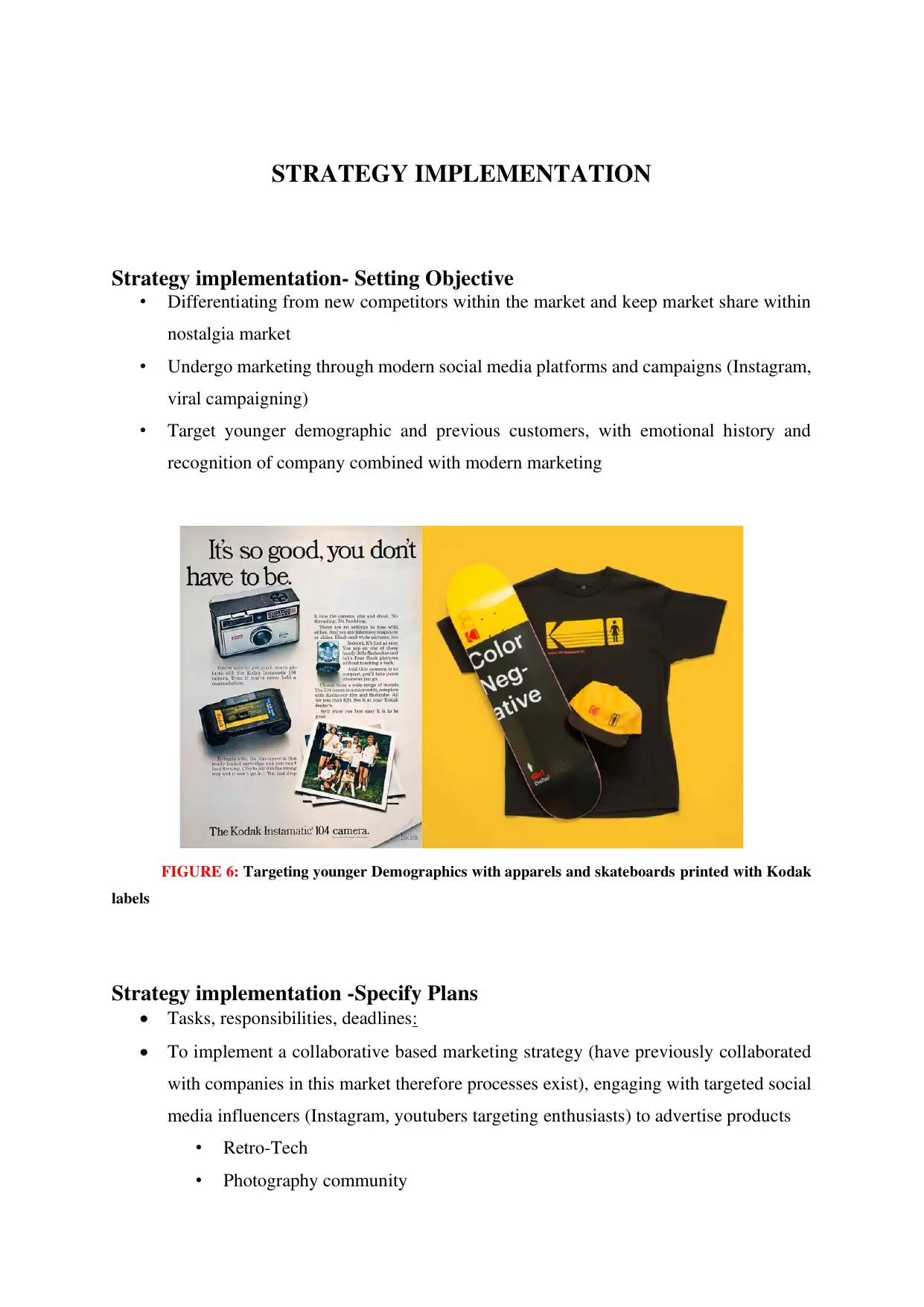
STRATEGY IMPLEMENTATION
Strategy implementation- Setting Objective
• Differentiating from new competitors within the market and keep market share within
nostalgia market
• Undergo marketing through modern social media platforms and campaigns (Instagram,
viral campaigning)
• Target younger demographic and previous customers, with emotional history and
recognition of company combined with modern marketing
FIGURE 6: Targeting younger Demographics with apparels and skateboards printed with Kodak
labels
Strategy implementation -Specify Plans
• Tasks, responsibilities, deadlines:
• To implement a collaborative based marketing strategy (have previously collaborated
with companies in this market therefore processes exist), engaging with targeted social
media influencers (Instagram, youtubers targeting enthusiasts) to advertise products
• Retro-Tech
• Photography community
Strategy implementation- Setting Objective
• Differentiating from new competitors within the market and keep market share within
nostalgia market
• Undergo marketing through modern social media platforms and campaigns (Instagram,
viral campaigning)
• Target younger demographic and previous customers, with emotional history and
recognition of company combined with modern marketing
FIGURE 6: Targeting younger Demographics with apparels and skateboards printed with Kodak
labels
Strategy implementation -Specify Plans
• Tasks, responsibilities, deadlines:
• To implement a collaborative based marketing strategy (have previously collaborated
with companies in this market therefore processes exist), engaging with targeted social
media influencers (Instagram, youtubers targeting enthusiasts) to advertise products
• Retro-Tech
• Photography community

Implement by end of the year, trends move quickly, competitors could already have similar
strategies
Strategy Implementation - Resource Allocation/Budget
Internal Resource
• Internal marketing resources exist within the company that have experience
undertaking collaborative marketing exercises (fashion, magazine), use team to identify
and engage with marketing platforms.
• Internal resource for managing identified and agreed influencers/platform
External Resource
• Budget required for engaging and using social media marketing platforms (influencers)
Strategy Implementation -Measurement/Management
• Measure against performance metrics:
• Market share within retro/nostalgia tech
• Sales Growth
• Revenue/Profit of consumer division
• Performance against metrics can determine whether sustained investment into
marketing approach is worth continuing
Strategy Justification
• Highlighted as Threat/ Weakness against TOWS Matrix
• Innovation implementation - first ones to bring digital cameras into market decided to
direct investment elsewhere, failed to capitalise on market to protect sales in film (W2)
• Kodak highly capitalizing in nostalgia market, many competitors are beginning to join
(Fujifilm, Sony) (T1)
• Value chain analysis shows that marketing processes exist within business, allowing
for quick implementation of strategy
• Dependent on success whether there is continued investment in strategy
strategies
Strategy Implementation - Resource Allocation/Budget
Internal Resource
• Internal marketing resources exist within the company that have experience
undertaking collaborative marketing exercises (fashion, magazine), use team to identify
and engage with marketing platforms.
• Internal resource for managing identified and agreed influencers/platform
External Resource
• Budget required for engaging and using social media marketing platforms (influencers)
Strategy Implementation -Measurement/Management
• Measure against performance metrics:
• Market share within retro/nostalgia tech
• Sales Growth
• Revenue/Profit of consumer division
• Performance against metrics can determine whether sustained investment into
marketing approach is worth continuing
Strategy Justification
• Highlighted as Threat/ Weakness against TOWS Matrix
• Innovation implementation - first ones to bring digital cameras into market decided to
direct investment elsewhere, failed to capitalise on market to protect sales in film (W2)
• Kodak highly capitalizing in nostalgia market, many competitors are beginning to join
(Fujifilm, Sony) (T1)
• Value chain analysis shows that marketing processes exist within business, allowing
for quick implementation of strategy
• Dependent on success whether there is continued investment in strategy
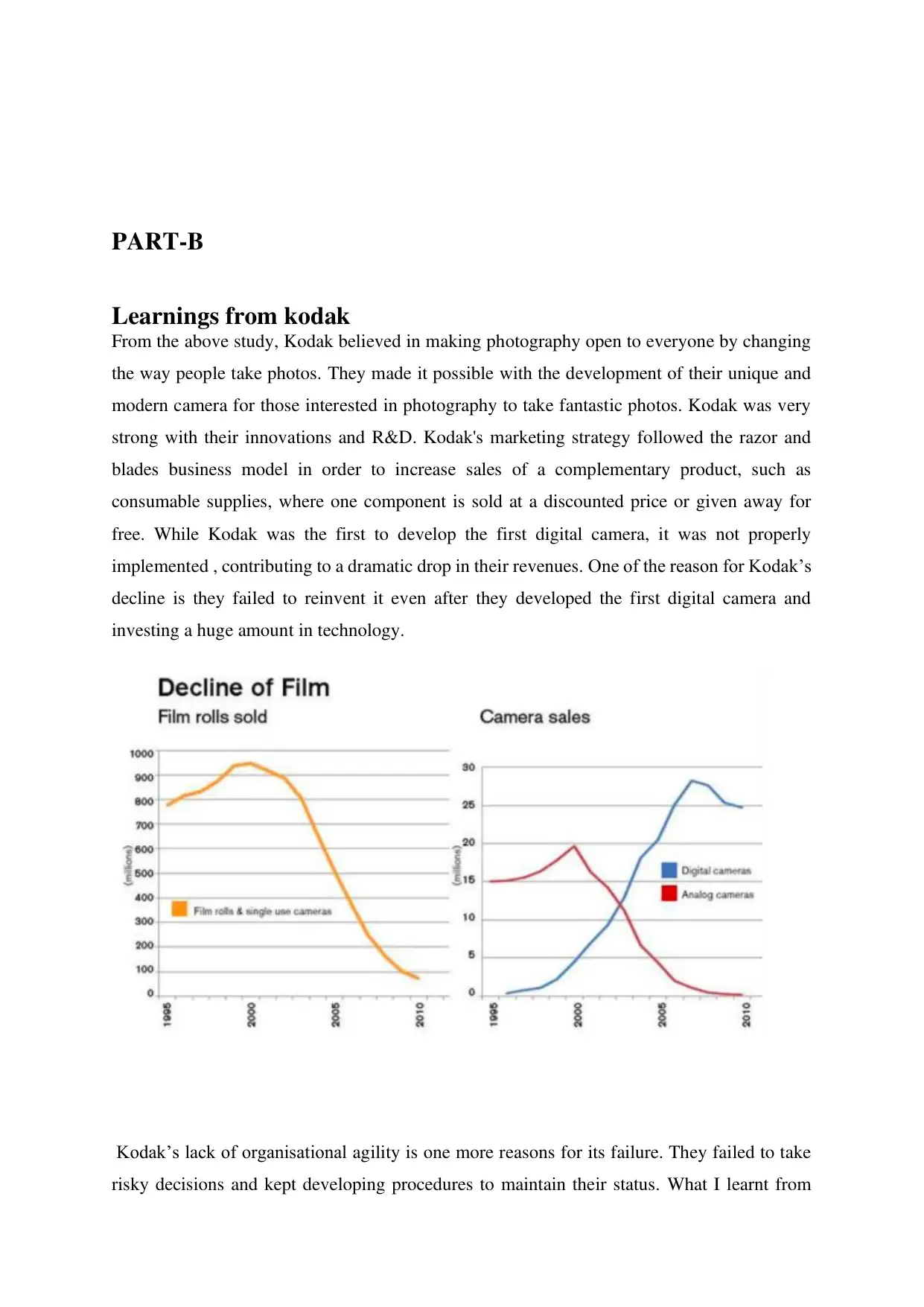
PART-B
Learnings from kodak
From the above study, Kodak believed in making photography open to everyone by changing
the way people take photos. They made it possible with the development of their unique and
modern camera for those interested in photography to take fantastic photos. Kodak was very
strong with their innovations and R&D. Kodak's marketing strategy followed the razor and
blades business model in order to increase sales of a complementary product, such as
consumable supplies, where one component is sold at a discounted price or given away for
free. While Kodak was the first to develop the first digital camera, it was not properly
implemented , contributing to a dramatic drop in their revenues. One of the reason for Kodak’s
decline is they failed to reinvent it even after they developed the first digital camera and
investing a huge amount in technology.
Kodak’s lack of organisational agility is one more reasons for its failure. They failed to take
risky decisions and kept developing procedures to maintain their status. What I learnt from
Learnings from kodak
From the above study, Kodak believed in making photography open to everyone by changing
the way people take photos. They made it possible with the development of their unique and
modern camera for those interested in photography to take fantastic photos. Kodak was very
strong with their innovations and R&D. Kodak's marketing strategy followed the razor and
blades business model in order to increase sales of a complementary product, such as
consumable supplies, where one component is sold at a discounted price or given away for
free. While Kodak was the first to develop the first digital camera, it was not properly
implemented , contributing to a dramatic drop in their revenues. One of the reason for Kodak’s
decline is they failed to reinvent it even after they developed the first digital camera and
investing a huge amount in technology.
Kodak’s lack of organisational agility is one more reasons for its failure. They failed to take
risky decisions and kept developing procedures to maintain their status. What I learnt from
Paraphrase This Document
Need a fresh take? Get an instant paraphrase of this document with our AI Paraphraser

Kodak’s decline is how should we transform the considered plan, business models and
management of innovation and how to adopt moving quick and easy as an organisational
strategy for future development.
Strategy for Kodak:
Kodak can differentiate from new competitors within the market and hold market share within
nostalgia market with increase in building Nostalgic feeling , business go back to their primary
roots in their initial or former identities. Kodak can target younger demographic and their loyal
customer, with emotional history and recognition of company combined with modern
marketing. Undergoing marketing through social media platforms and campaigns(Instagram,
Facebook, viral campaigning) will also be one good strategy for their business. For
Implementation of this strategy ,
• Kodak can organise few competitions like Live photography using their own film
camera for professionals , Portfolio building for aspiring models using kodak products
followed by posting it in social media promoting “Kodak” and skate board events for
kids in streets and presenting exciting gifts to the winners with kodak stickered skate
board, Instant camera, Apparels etc.
• Continuous advertisements on Instagram or playing it while watching videos in
Facebook will attract public wanting to try the old school photography.
• Setting up new Insta hashtag challenge in Instagram (3rd Top social media marketing
) (Anon., 2020)with Film photography would be a major impact with public to recollect
their olden days.
• Hiring youngsters to keep updating the trend on social media which will be the primary
strategy for modern marketing.
By this strategy, Kodak can restore their brand image and increase the sales revenue. They
can increase their market share with nostalgia/ retro and they can determine their
performance against metric whether the investment into marketing approach is successful
and to check if its worth continuing. Restoring their Brand image would reflect in
volunteering collaborations by magazines and fashions etc. Profit of consumer division
will also be increased. I feel targeting younger demographic, marketing through social
media and differentiating within new competitors with nostalgia would be the best business
strategy for Kodak because future is all about digital and digital marketing. Hence,
Focusing marketing through social media would be effective, economical and ethical. Sales
management of innovation and how to adopt moving quick and easy as an organisational
strategy for future development.
Strategy for Kodak:
Kodak can differentiate from new competitors within the market and hold market share within
nostalgia market with increase in building Nostalgic feeling , business go back to their primary
roots in their initial or former identities. Kodak can target younger demographic and their loyal
customer, with emotional history and recognition of company combined with modern
marketing. Undergoing marketing through social media platforms and campaigns(Instagram,
Facebook, viral campaigning) will also be one good strategy for their business. For
Implementation of this strategy ,
• Kodak can organise few competitions like Live photography using their own film
camera for professionals , Portfolio building for aspiring models using kodak products
followed by posting it in social media promoting “Kodak” and skate board events for
kids in streets and presenting exciting gifts to the winners with kodak stickered skate
board, Instant camera, Apparels etc.
• Continuous advertisements on Instagram or playing it while watching videos in
Facebook will attract public wanting to try the old school photography.
• Setting up new Insta hashtag challenge in Instagram (3rd Top social media marketing
) (Anon., 2020)with Film photography would be a major impact with public to recollect
their olden days.
• Hiring youngsters to keep updating the trend on social media which will be the primary
strategy for modern marketing.
By this strategy, Kodak can restore their brand image and increase the sales revenue. They
can increase their market share with nostalgia/ retro and they can determine their
performance against metric whether the investment into marketing approach is successful
and to check if its worth continuing. Restoring their Brand image would reflect in
volunteering collaborations by magazines and fashions etc. Profit of consumer division
will also be increased. I feel targeting younger demographic, marketing through social
media and differentiating within new competitors with nostalgia would be the best business
strategy for Kodak because future is all about digital and digital marketing. Hence,
Focusing marketing through social media would be effective, economical and ethical. Sales

of cameras and films can only be boosted by targeting younger people and loyal customers.
We can attract younger people and middle aged through social media as they spend most
of their days in it.
Personal learnings about Strategy development
Beginning with my business vision, before the beginning of my studying, I did not access
how my vision was supported in the business but now considering myself as strategic
leader, My perspective has changed completely. I started learning business strategy with a
proper vision and a clear direction. I understood how Evaluating ,strategy and
implementation relates with business strategy. In business, planning is what drives
decisions. An successful plan will help you determine where your resources and money are
best invested by helping companies recognise their strengths and disadvantages. In
ensuring that the company has a profitable and prosperous future, these choices are critical.
A good strategy delivers a specific plan composed of a series of guiding principles or
guidelines that describe the actions that persons in the organisation can take (and not take)
and the things they should prioritise (and not prioritise) in order to accomplish the required
objectives. I have learnt many tools like Tows matrix, BCG matrix, Pestle analysis, Swot,
porter’s 5 forces etc which helped me to align and distinguish my strategy for an
organisation. In developing a strategy, it is fundamental to determine which target
community of consumers, varieties, and needs the organisation can represent. By strategy
development, I learnt how to save myself time, money and effort. I realised goal settings
plays a vital role and strategy are key to business. Being creativity is an essential factor in
this development. Finding out SBU’s for the organisation and analysing them using all the
above mentioned tools and finally coming up with a strategy and strategy implementation.
Personally, I feel implementation is more important than setting up an strategy and how
to succeed in it by specifying plans. Competitors may have the same approach, so it relies
on how well we implement it. Management should also work together by giving their best
by analysing their Performance against metrics, comparing sales growth. I feel confident
on doing a business strategy and implementing it for an organisation on my own. I had got
more view points on how to analyse in a proper procedure. Anyone may suggest key
actions, but before undertaking on the action plans, it is the successful professional, or
executive who often plans a strategy or easily creates a new strategy when they see that the
action steps do not work the way they should be. Business level tactics, on the other hand,
include ways in which an organisation will aim to gain strategic advantage by efficient
We can attract younger people and middle aged through social media as they spend most
of their days in it.
Personal learnings about Strategy development
Beginning with my business vision, before the beginning of my studying, I did not access
how my vision was supported in the business but now considering myself as strategic
leader, My perspective has changed completely. I started learning business strategy with a
proper vision and a clear direction. I understood how Evaluating ,strategy and
implementation relates with business strategy. In business, planning is what drives
decisions. An successful plan will help you determine where your resources and money are
best invested by helping companies recognise their strengths and disadvantages. In
ensuring that the company has a profitable and prosperous future, these choices are critical.
A good strategy delivers a specific plan composed of a series of guiding principles or
guidelines that describe the actions that persons in the organisation can take (and not take)
and the things they should prioritise (and not prioritise) in order to accomplish the required
objectives. I have learnt many tools like Tows matrix, BCG matrix, Pestle analysis, Swot,
porter’s 5 forces etc which helped me to align and distinguish my strategy for an
organisation. In developing a strategy, it is fundamental to determine which target
community of consumers, varieties, and needs the organisation can represent. By strategy
development, I learnt how to save myself time, money and effort. I realised goal settings
plays a vital role and strategy are key to business. Being creativity is an essential factor in
this development. Finding out SBU’s for the organisation and analysing them using all the
above mentioned tools and finally coming up with a strategy and strategy implementation.
Personally, I feel implementation is more important than setting up an strategy and how
to succeed in it by specifying plans. Competitors may have the same approach, so it relies
on how well we implement it. Management should also work together by giving their best
by analysing their Performance against metrics, comparing sales growth. I feel confident
on doing a business strategy and implementing it for an organisation on my own. I had got
more view points on how to analyse in a proper procedure. Anyone may suggest key
actions, but before undertaking on the action plans, it is the successful professional, or
executive who often plans a strategy or easily creates a new strategy when they see that the
action steps do not work the way they should be. Business level tactics, on the other hand,
include ways in which an organisation will aim to gain strategic advantage by efficient
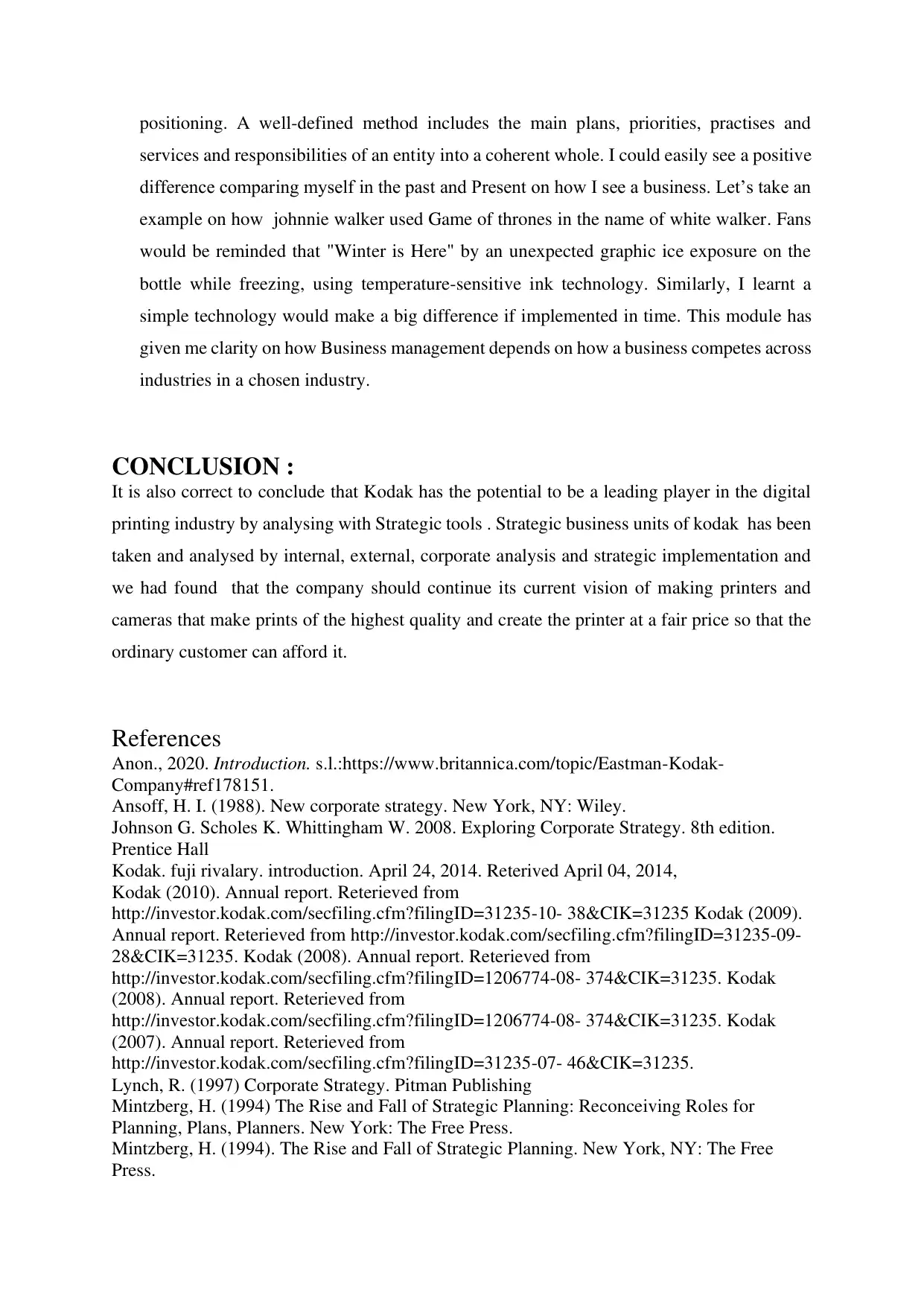
positioning. A well-defined method includes the main plans, priorities, practises and
services and responsibilities of an entity into a coherent whole. I could easily see a positive
difference comparing myself in the past and Present on how I see a business. Let’s take an
example on how johnnie walker used Game of thrones in the name of white walker. Fans
would be reminded that "Winter is Here" by an unexpected graphic ice exposure on the
bottle while freezing, using temperature-sensitive ink technology. Similarly, I learnt a
simple technology would make a big difference if implemented in time. This module has
given me clarity on how Business management depends on how a business competes across
industries in a chosen industry.
CONCLUSION :
It is also correct to conclude that Kodak has the potential to be a leading player in the digital
printing industry by analysing with Strategic tools . Strategic business units of kodak has been
taken and analysed by internal, external, corporate analysis and strategic implementation and
we had found that the company should continue its current vision of making printers and
cameras that make prints of the highest quality and create the printer at a fair price so that the
ordinary customer can afford it.
References
Anon., 2020. Introduction. s.l.:https://www.britannica.com/topic/Eastman-Kodak-
Company#ref178151.
Ansoff, H. I. (1988). New corporate strategy. New York, NY: Wiley.
Johnson G. Scholes K. Whittingham W. 2008. Exploring Corporate Strategy. 8th edition.
Prentice Hall
Kodak. fuji rivalary. introduction. April 24, 2014. Reterived April 04, 2014,
Kodak (2010). Annual report. Reterieved from
http://investor.kodak.com/secfiling.cfm?filingID=31235-10- 38&CIK=31235 Kodak (2009).
Annual report. Reterieved from http://investor.kodak.com/secfiling.cfm?filingID=31235-09-
28&CIK=31235. Kodak (2008). Annual report. Reterieved from
http://investor.kodak.com/secfiling.cfm?filingID=1206774-08- 374&CIK=31235. Kodak
(2008). Annual report. Reterieved from
http://investor.kodak.com/secfiling.cfm?filingID=1206774-08- 374&CIK=31235. Kodak
(2007). Annual report. Reterieved from
http://investor.kodak.com/secfiling.cfm?filingID=31235-07- 46&CIK=31235.
Lynch, R. (1997) Corporate Strategy. Pitman Publishing
Mintzberg, H. (1994) The Rise and Fall of Strategic Planning: Reconceiving Roles for
Planning, Plans, Planners. New York: The Free Press.
Mintzberg, H. (1994). The Rise and Fall of Strategic Planning. New York, NY: The Free
Press.
services and responsibilities of an entity into a coherent whole. I could easily see a positive
difference comparing myself in the past and Present on how I see a business. Let’s take an
example on how johnnie walker used Game of thrones in the name of white walker. Fans
would be reminded that "Winter is Here" by an unexpected graphic ice exposure on the
bottle while freezing, using temperature-sensitive ink technology. Similarly, I learnt a
simple technology would make a big difference if implemented in time. This module has
given me clarity on how Business management depends on how a business competes across
industries in a chosen industry.
CONCLUSION :
It is also correct to conclude that Kodak has the potential to be a leading player in the digital
printing industry by analysing with Strategic tools . Strategic business units of kodak has been
taken and analysed by internal, external, corporate analysis and strategic implementation and
we had found that the company should continue its current vision of making printers and
cameras that make prints of the highest quality and create the printer at a fair price so that the
ordinary customer can afford it.
References
Anon., 2020. Introduction. s.l.:https://www.britannica.com/topic/Eastman-Kodak-
Company#ref178151.
Ansoff, H. I. (1988). New corporate strategy. New York, NY: Wiley.
Johnson G. Scholes K. Whittingham W. 2008. Exploring Corporate Strategy. 8th edition.
Prentice Hall
Kodak. fuji rivalary. introduction. April 24, 2014. Reterived April 04, 2014,
Kodak (2010). Annual report. Reterieved from
http://investor.kodak.com/secfiling.cfm?filingID=31235-10- 38&CIK=31235 Kodak (2009).
Annual report. Reterieved from http://investor.kodak.com/secfiling.cfm?filingID=31235-09-
28&CIK=31235. Kodak (2008). Annual report. Reterieved from
http://investor.kodak.com/secfiling.cfm?filingID=1206774-08- 374&CIK=31235. Kodak
(2008). Annual report. Reterieved from
http://investor.kodak.com/secfiling.cfm?filingID=1206774-08- 374&CIK=31235. Kodak
(2007). Annual report. Reterieved from
http://investor.kodak.com/secfiling.cfm?filingID=31235-07- 46&CIK=31235.
Lynch, R. (1997) Corporate Strategy. Pitman Publishing
Mintzberg, H. (1994) The Rise and Fall of Strategic Planning: Reconceiving Roles for
Planning, Plans, Planners. New York: The Free Press.
Mintzberg, H. (1994). The Rise and Fall of Strategic Planning. New York, NY: The Free
Press.
Secure Best Marks with AI Grader
Need help grading? Try our AI Grader for instant feedback on your assignments.

Porter, M. (2001) Service Operations Strategy. Harvard Business School
NewStraightsTimes, (2012) Kodak’s Last Days. {online}
http://www.nst.com.my/opinion/editorial/kodak-s-last-days-1.42251 (cited on 30th May
2012)
Orcullo, N. (2007) Fundamentals of Strategic Management. Rex Bookstore, Inc.
Ukessay, 2018. Eastman Kodak Product.
s.l.:https://www.ukessays.com/essays/management/eastman-kodak-products.php.
Whittonton, R. (2001) What is Strategy and Does It Matter? Cengage Learning EMEA
Wootton and Horne, 1977 in Orcullo, (2007) Fundamentals of Strategic Management. Rex
Bookstore, Inc.
NewStraightsTimes, (2012) Kodak’s Last Days. {online}
http://www.nst.com.my/opinion/editorial/kodak-s-last-days-1.42251 (cited on 30th May
2012)
Orcullo, N. (2007) Fundamentals of Strategic Management. Rex Bookstore, Inc.
Ukessay, 2018. Eastman Kodak Product.
s.l.:https://www.ukessays.com/essays/management/eastman-kodak-products.php.
Whittonton, R. (2001) What is Strategy and Does It Matter? Cengage Learning EMEA
Wootton and Horne, 1977 in Orcullo, (2007) Fundamentals of Strategic Management. Rex
Bookstore, Inc.
1 out of 23
Your All-in-One AI-Powered Toolkit for Academic Success.
+13062052269
info@desklib.com
Available 24*7 on WhatsApp / Email
![[object Object]](/_next/static/media/star-bottom.7253800d.svg)
Unlock your academic potential
© 2024 | Zucol Services PVT LTD | All rights reserved.
